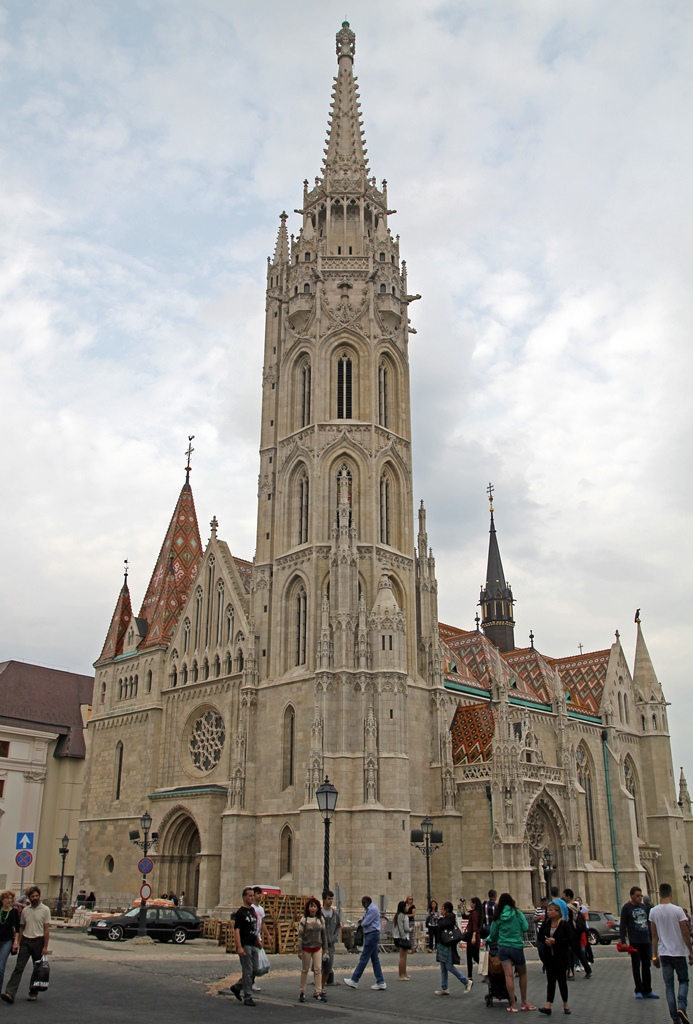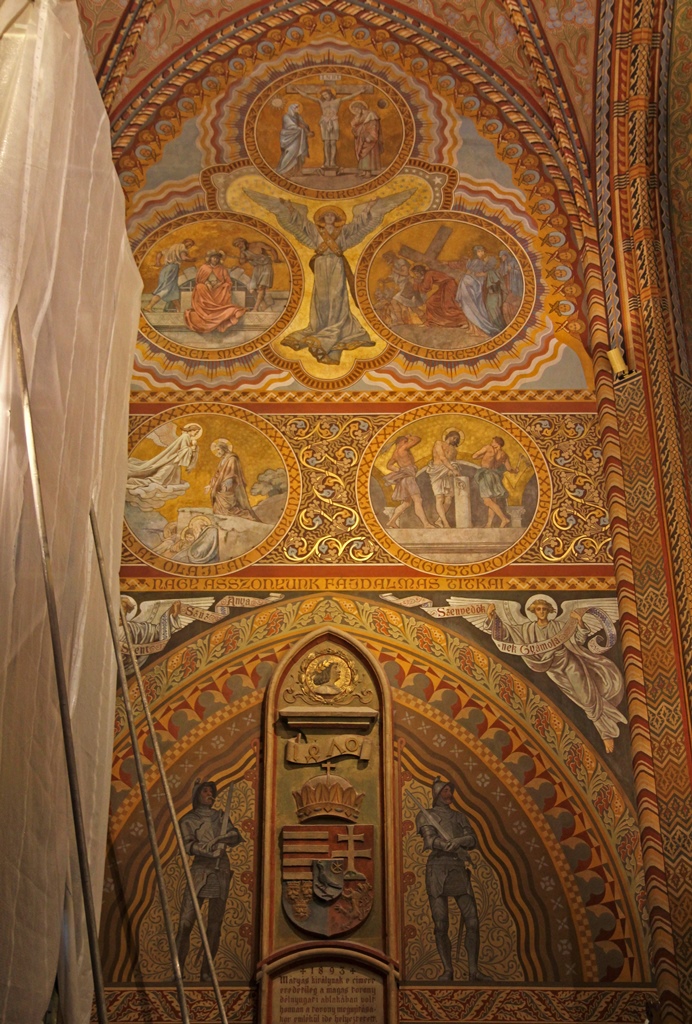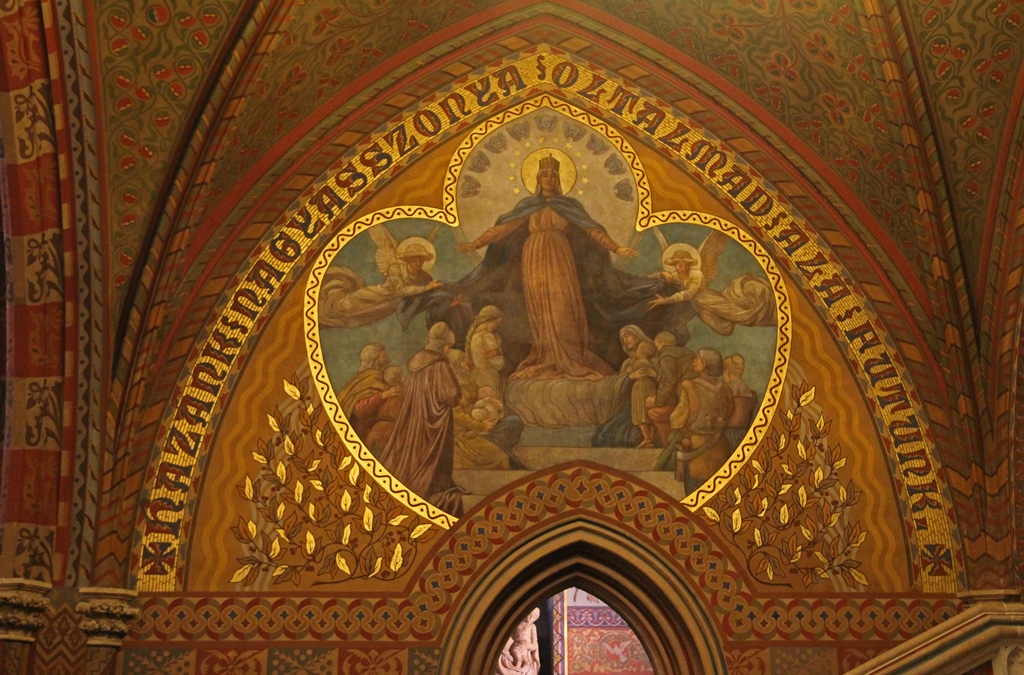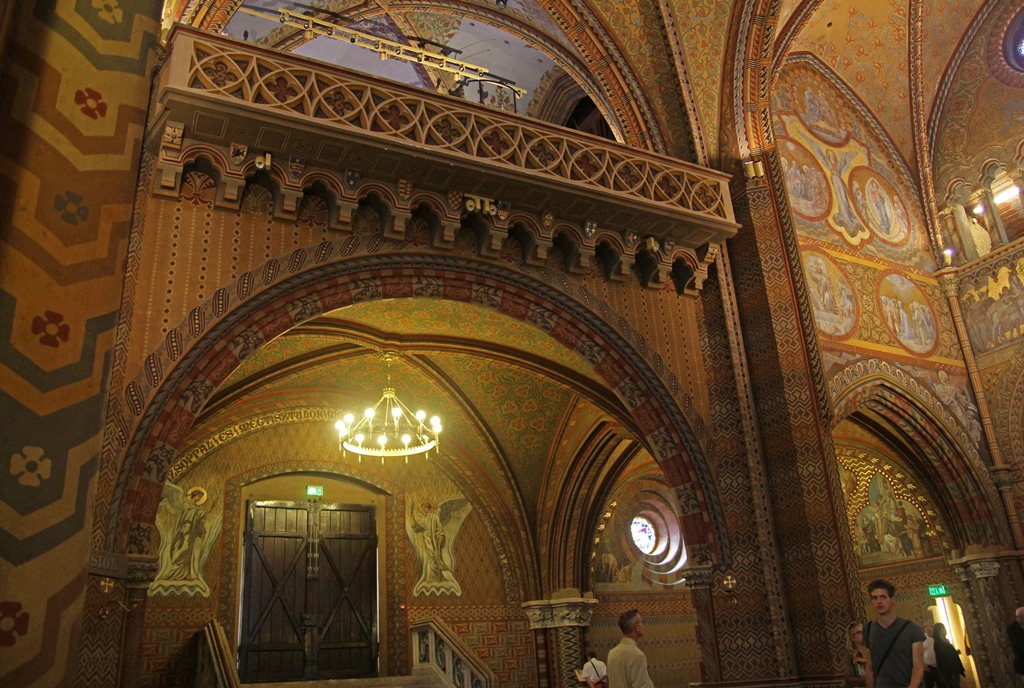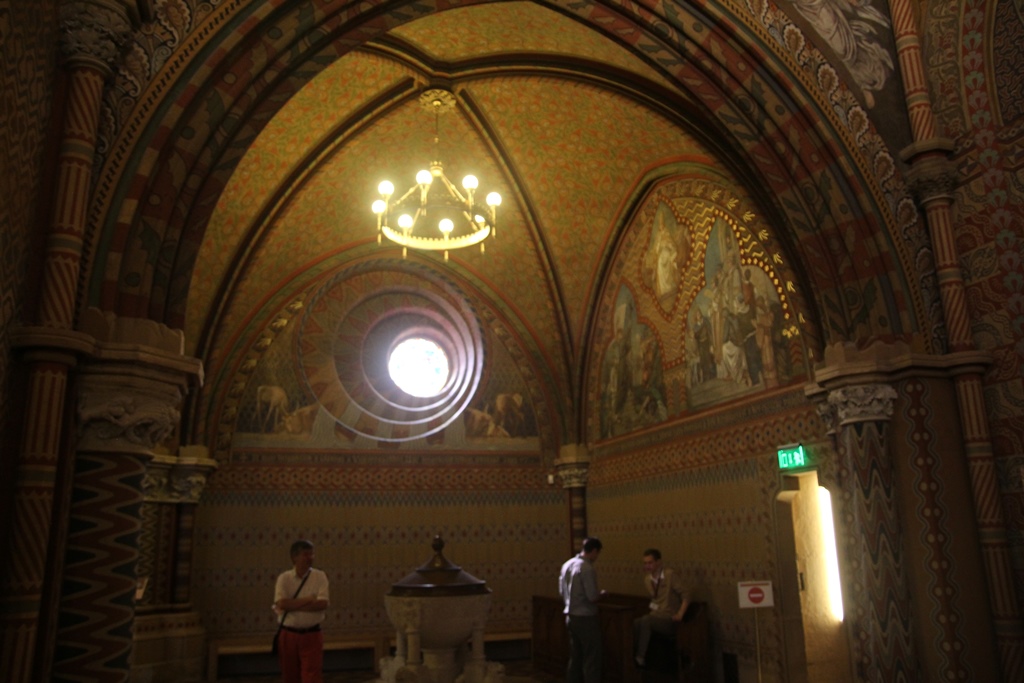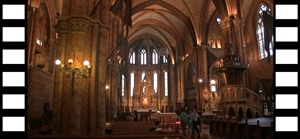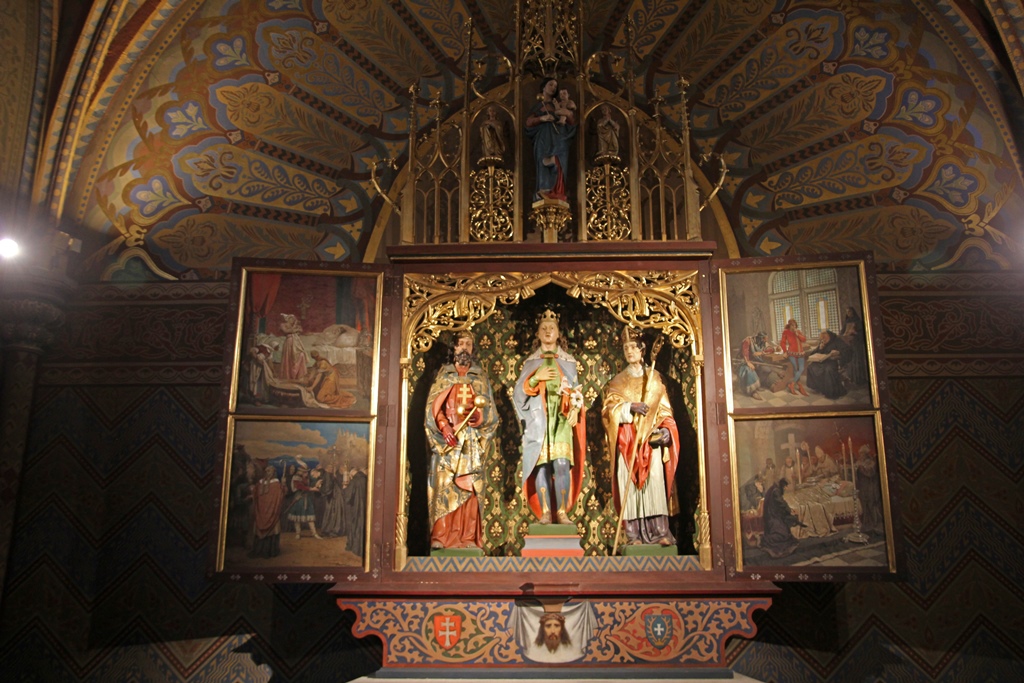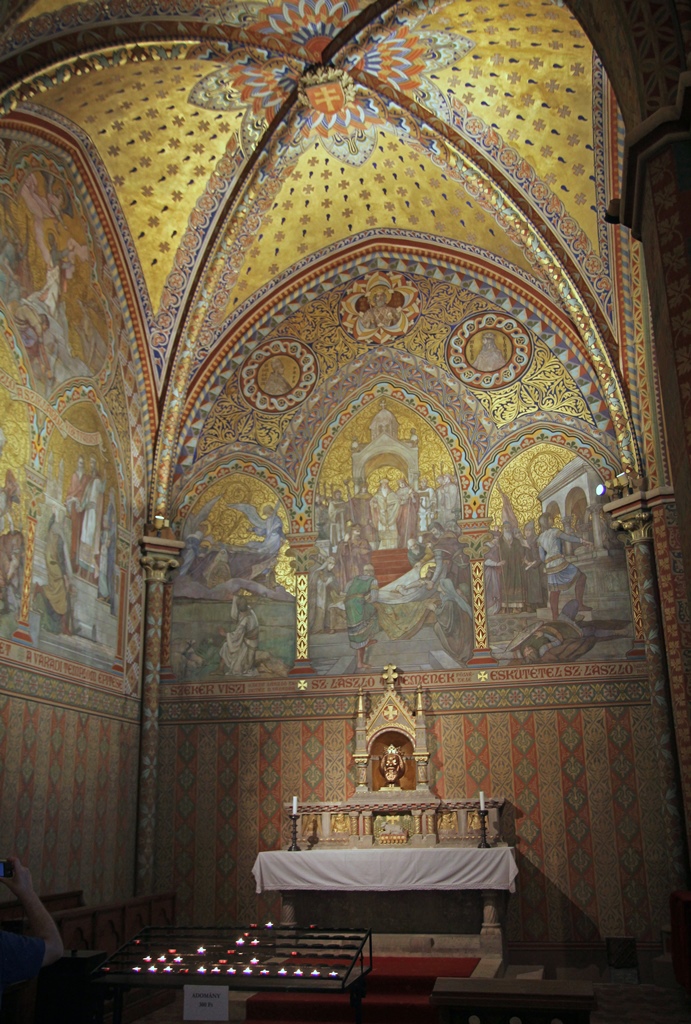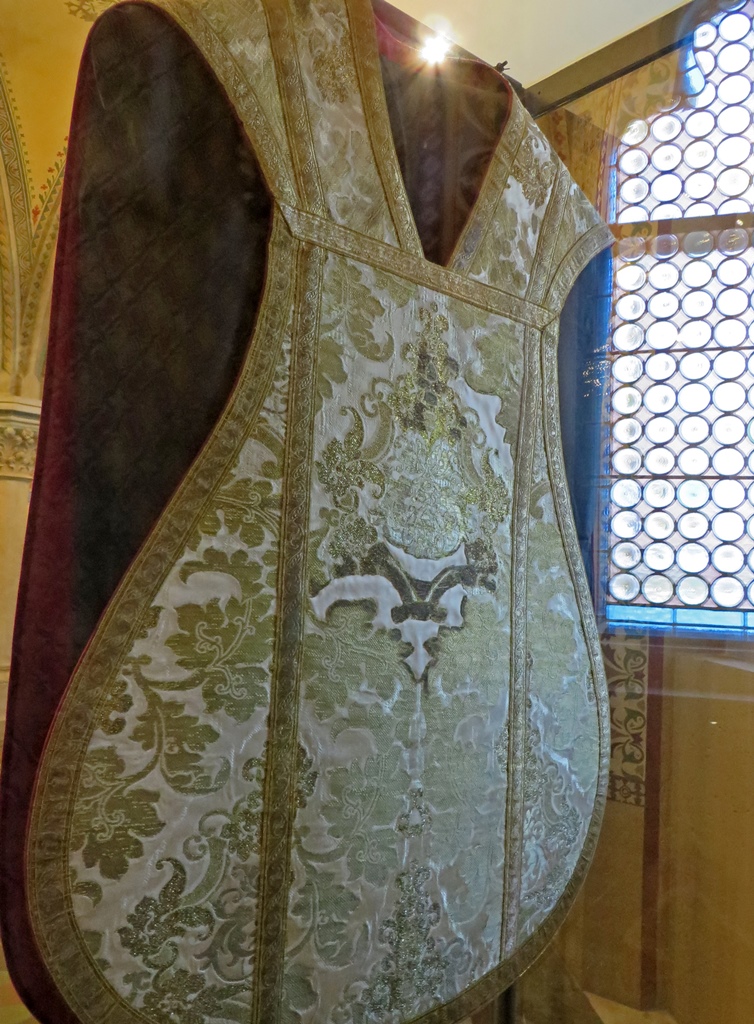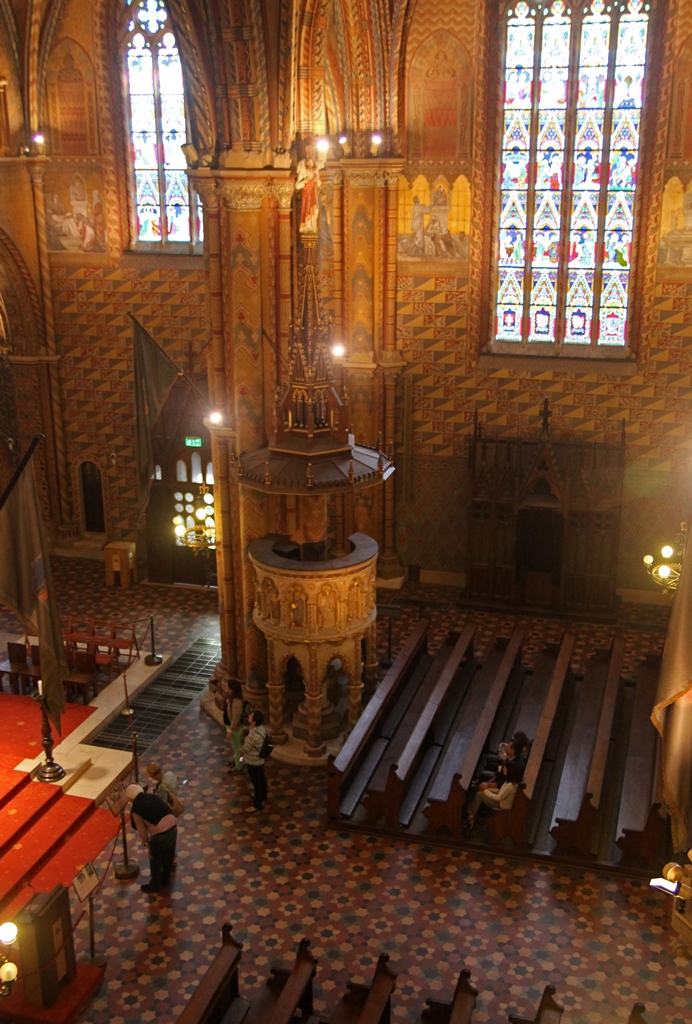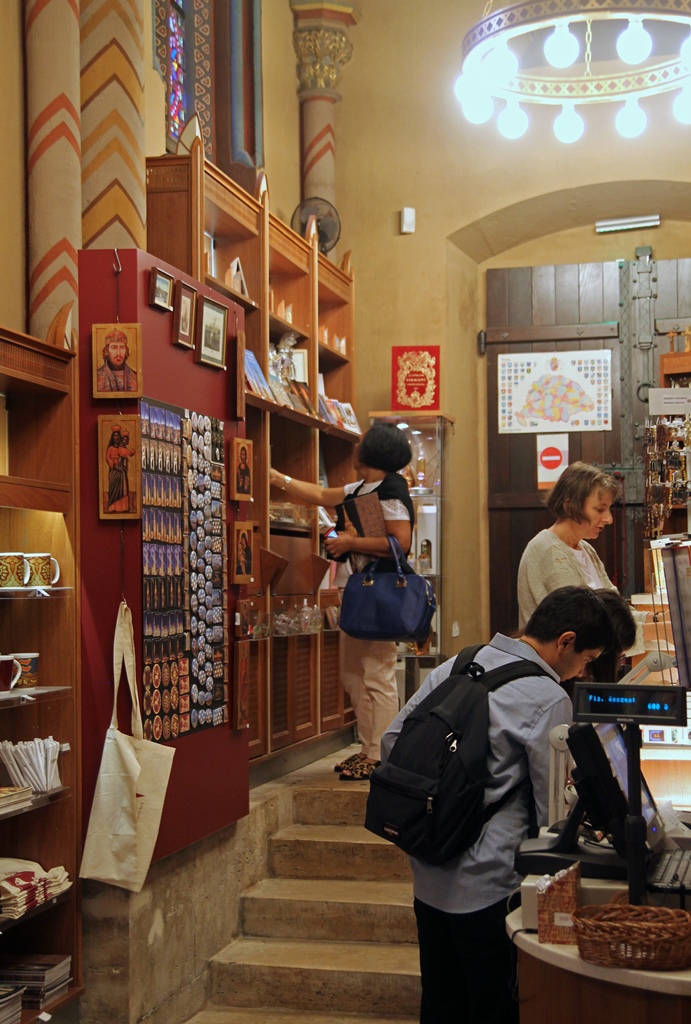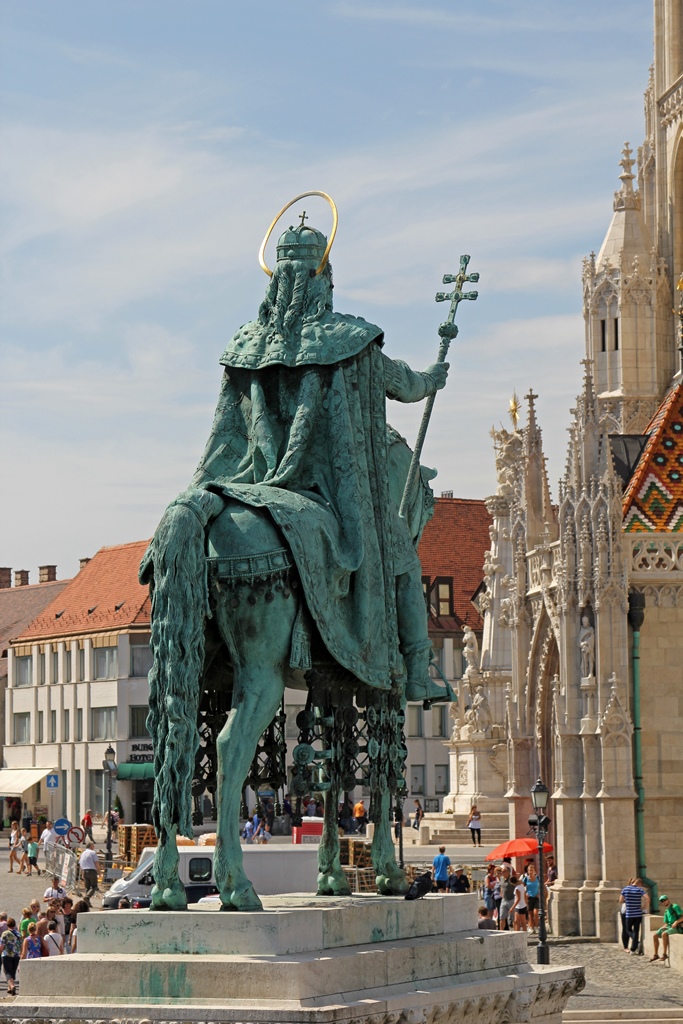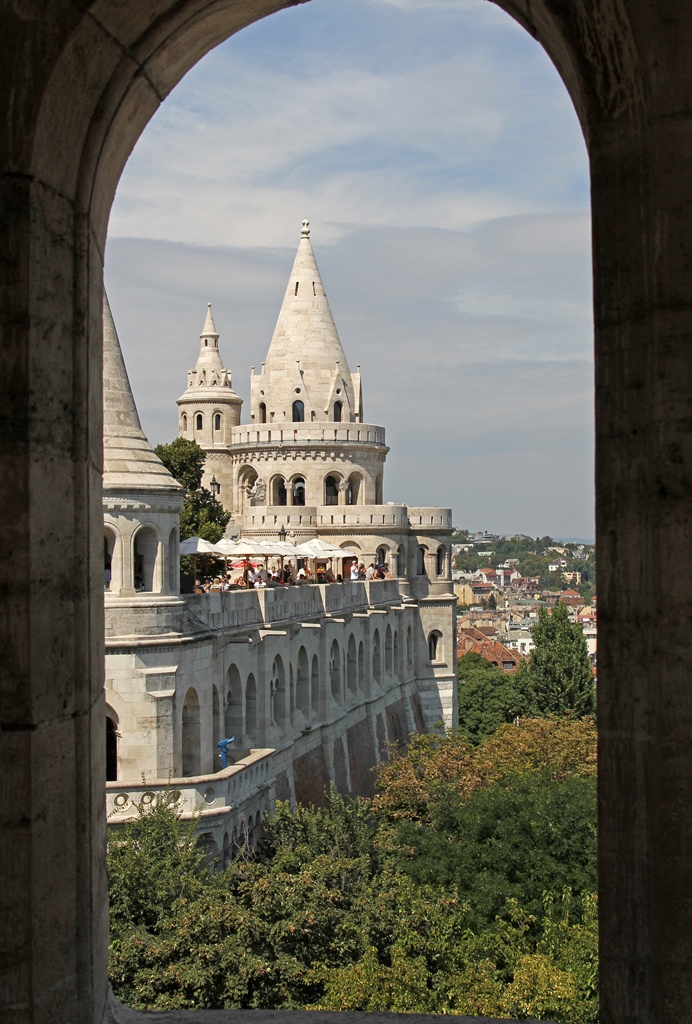Matthias Church
The Matthias Church, located
on the Buda side of the Danube, on Castle Hill, has a
long history, though its present configuration has only existed since the 19th Century.
The original church, founded by St. Stephen in 1015, was apparently Romanesque in
style, though no remains of this first church have been found. It wasn't known as
the Matthias Church yet, as this name came from King Matthias I, who was not born until
the 15th Century. It was first named (and technically still is named) after the Virgin
Mary, having been called things like "The Church of Mary" and "The Church of Our Lady
of Buda". The first church was destroyed by invading Mongols in 1241 and rebuilt later
in the same century at the order of King Béla IV, after the Mongols had receded. An
expansion of the church took place under King Sigismund shortly before the Renaissance
began, followed by an extensive renovation by King Matthias (1458-90), who was a
Renaissance man with Renaissance style. Matthias was crowned in the church, and was
also married there (twice!). Over the centuries, several crownings and weddings took
place in the church, including the coronations of the last two Habsburg kings, Franz
Joseph I (in 1867) and Charles IV (in 1916, during World War I).
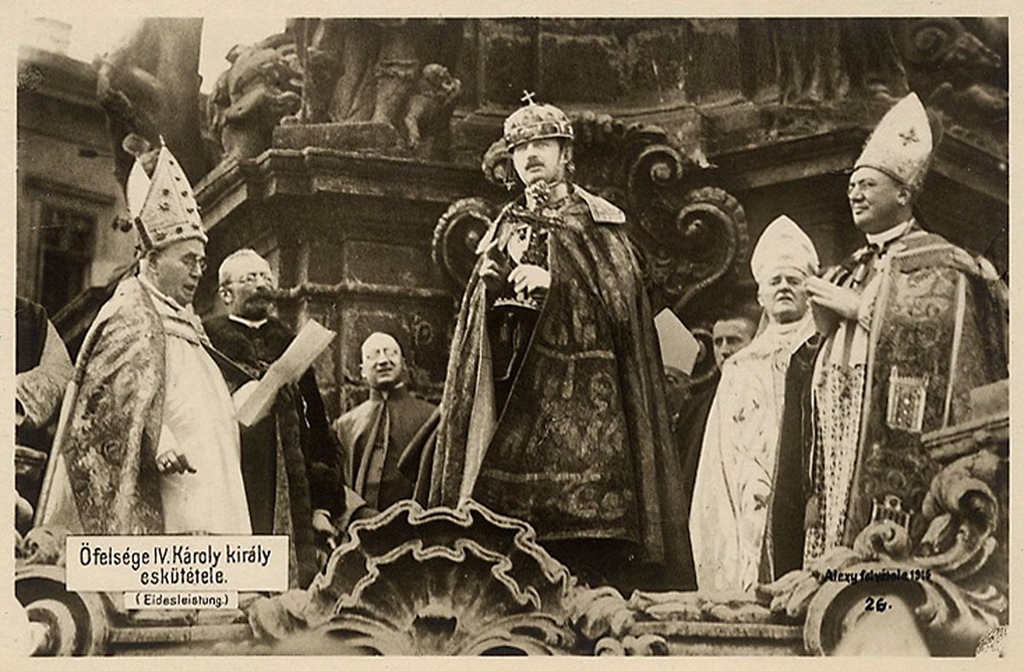
Coronation of Charles IV (1916)
None of Matthias's work on the church was appreciated by the Ottoman Turks, who
occupied the city in 1541 and turned it into a mosque. Nearly all of the Renaissance
ornamentation was discarded or whitewashed over. After the Turks were tossed out in
1686, an unconvincing attempt at making the church Baroque took place, but it wasn't
until a major redo in the 19th Century (by an architect named Frigyes Schulek) that
the church regained its earlier splendor. But again, war intervened, with both the
Nazis and the Soviets taking a toll on the structure, which was used to garrison
soldiers during World War II. Much of the damage was repaired between 1950 and 1970,
and a thorough restoration was conducted between 2006 and 2013. Just in time for us
to visit!
During our visit, everything did appear to be in good condition, though some plastic
sheeting and some piles of stone outside the church seemed to indicate there was
still work going on. Approaching the church, its roof tiles and central spire looked
brand-new. So did the doorway through which we entered (known as the Mary Gate),
even though the doorway incorporates the oldest surviving elements in the church,
from its Gothic era.
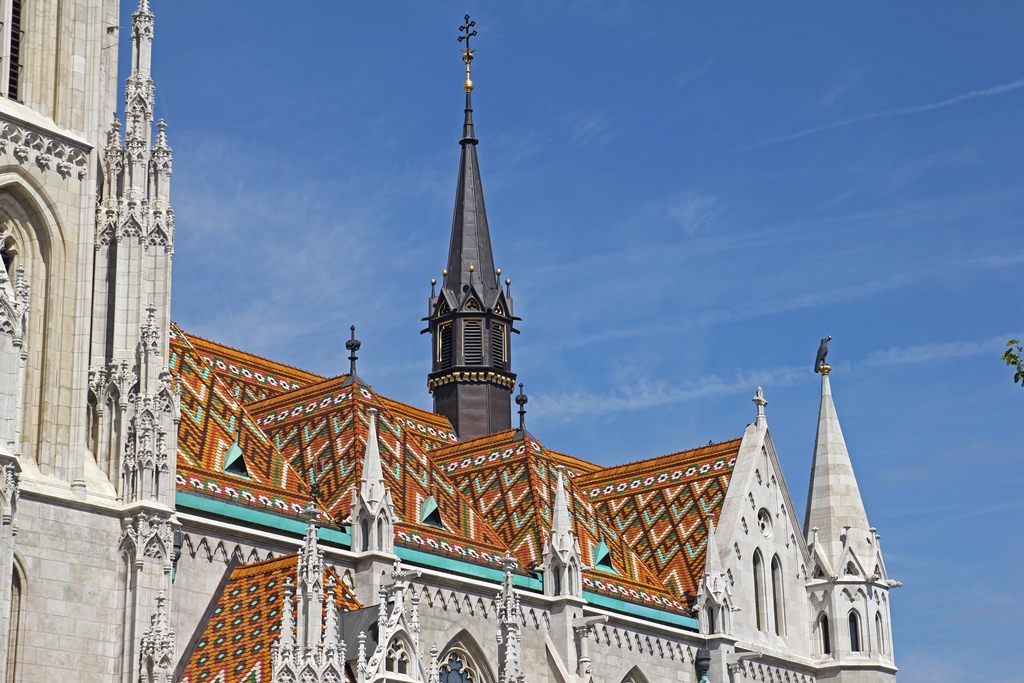
Roof, Matthias Church
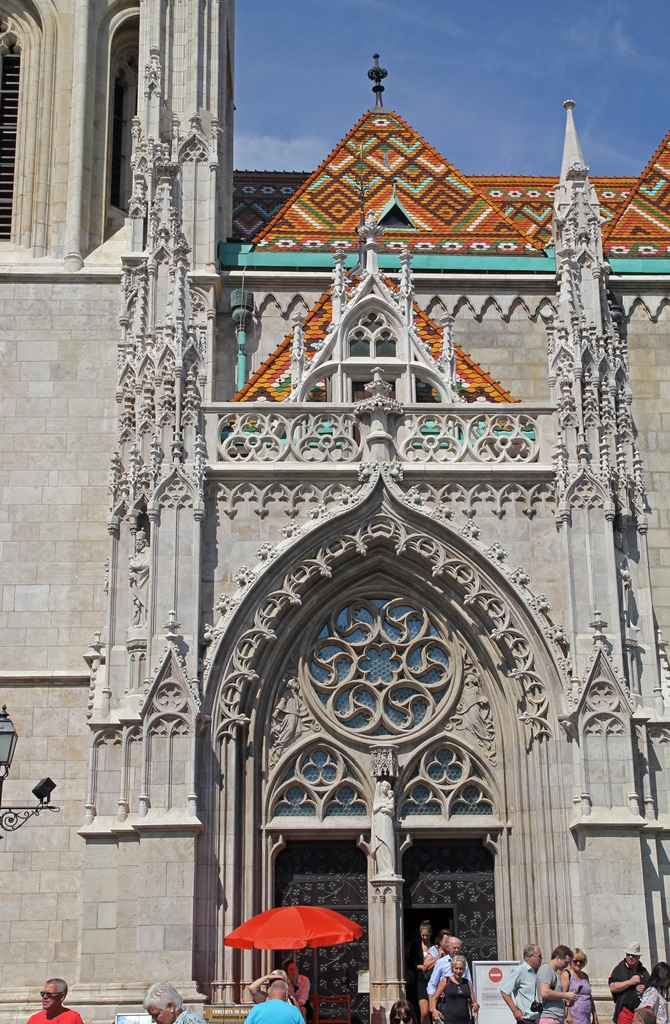
Mary Gate
The lighting inside the church was on the dim side, but it wasn't hard to see
that the restorers had done terrific work. There was still some plastic sheeting
partly covering the entrance doorway, but everything else looked beautiful, and
while the church had most of the features you would expect to find in any
Catholic church, it was quite different from any churches we'd visited before.
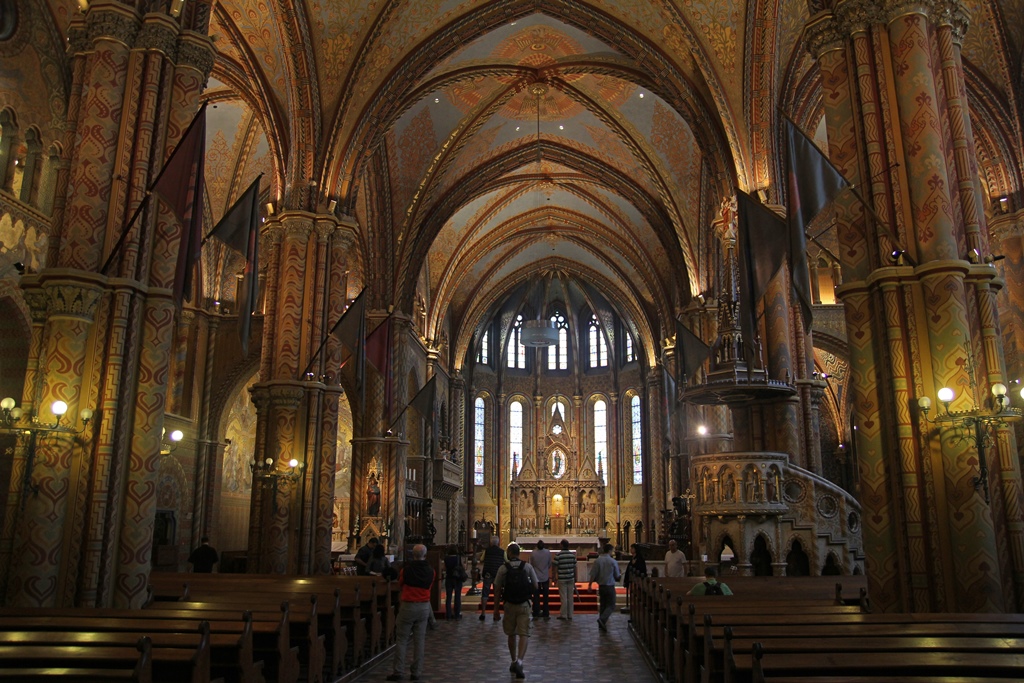
Inside Matthias Church
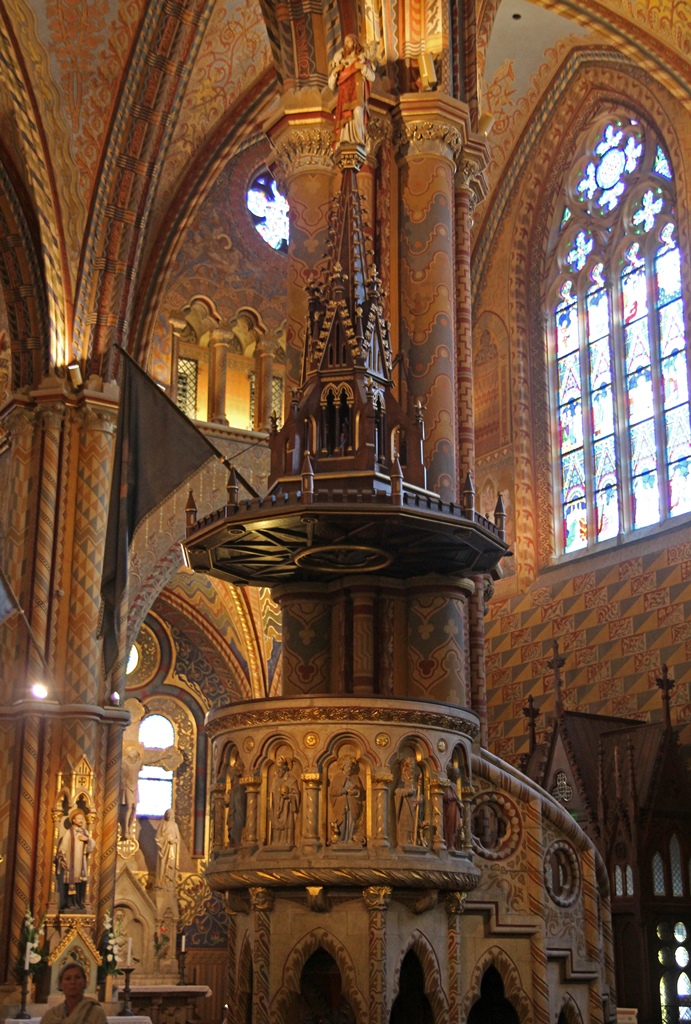
Pulpit
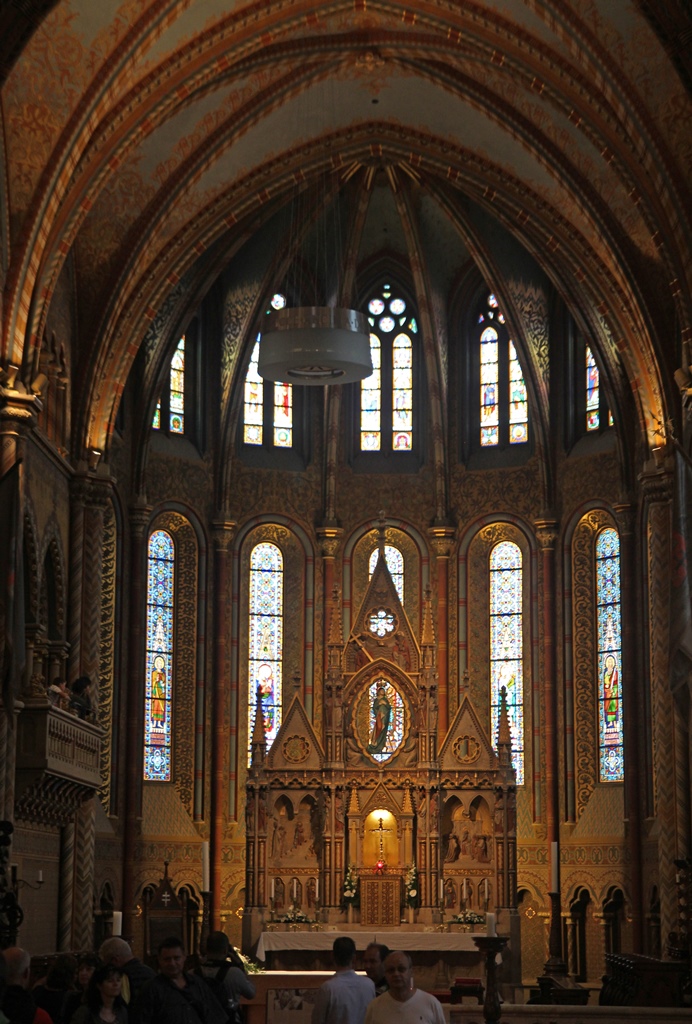
Main Altar
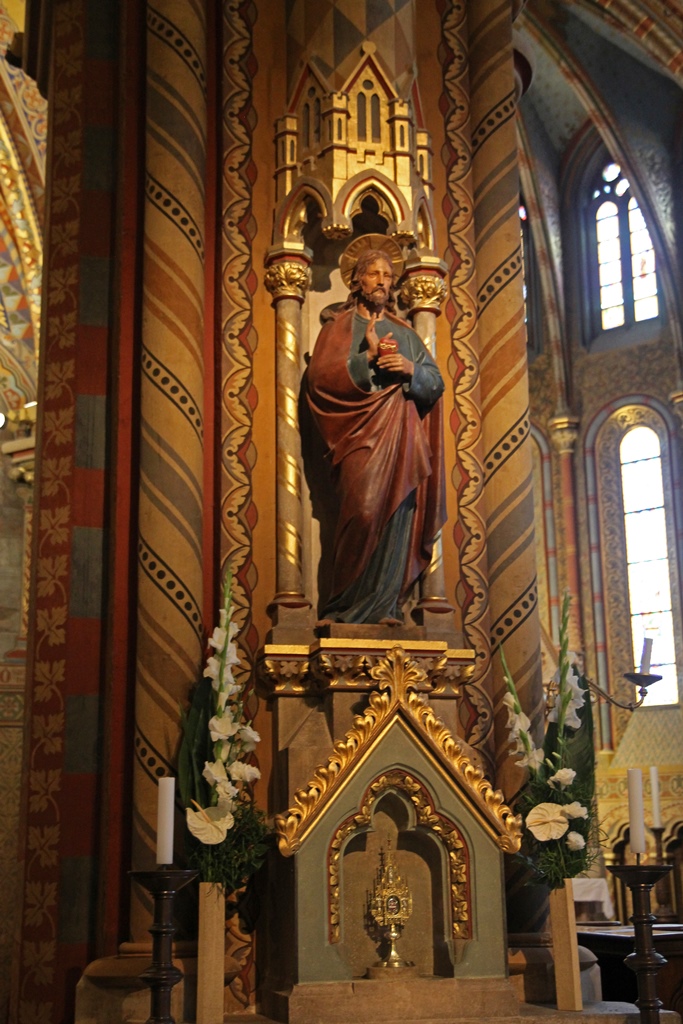
"Sacred Heart of Jesus" Figure
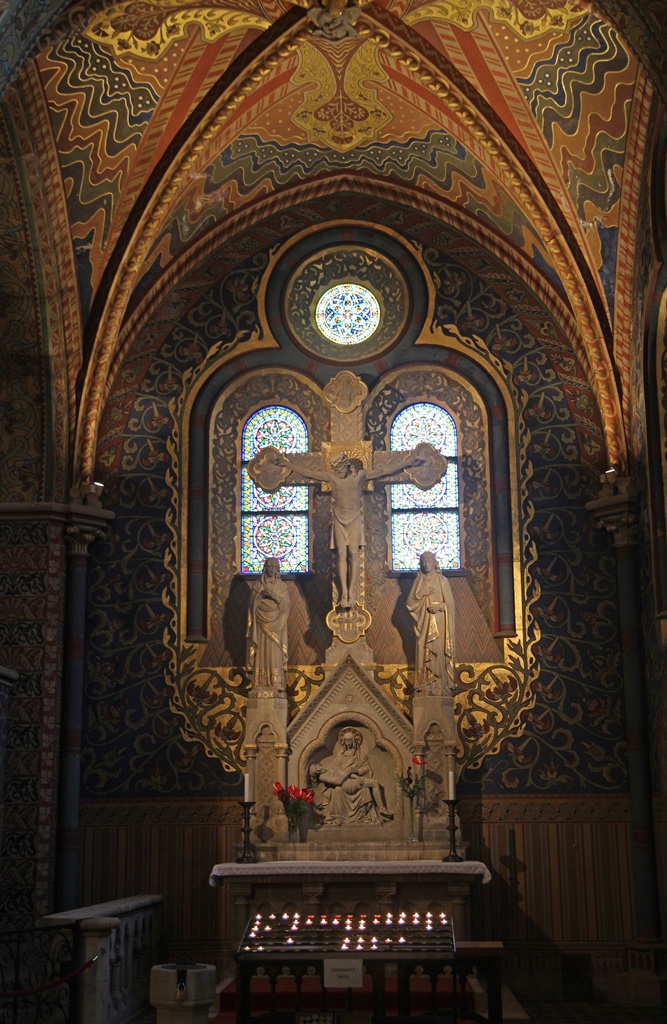
Holy Cross Altar
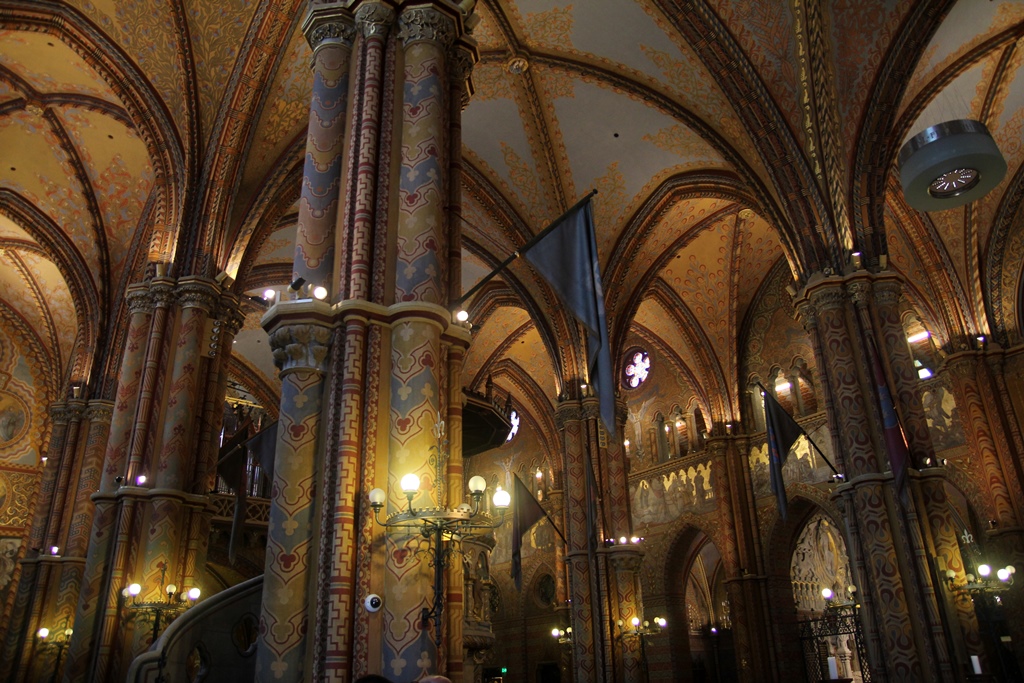
Church from Behind Pulpit
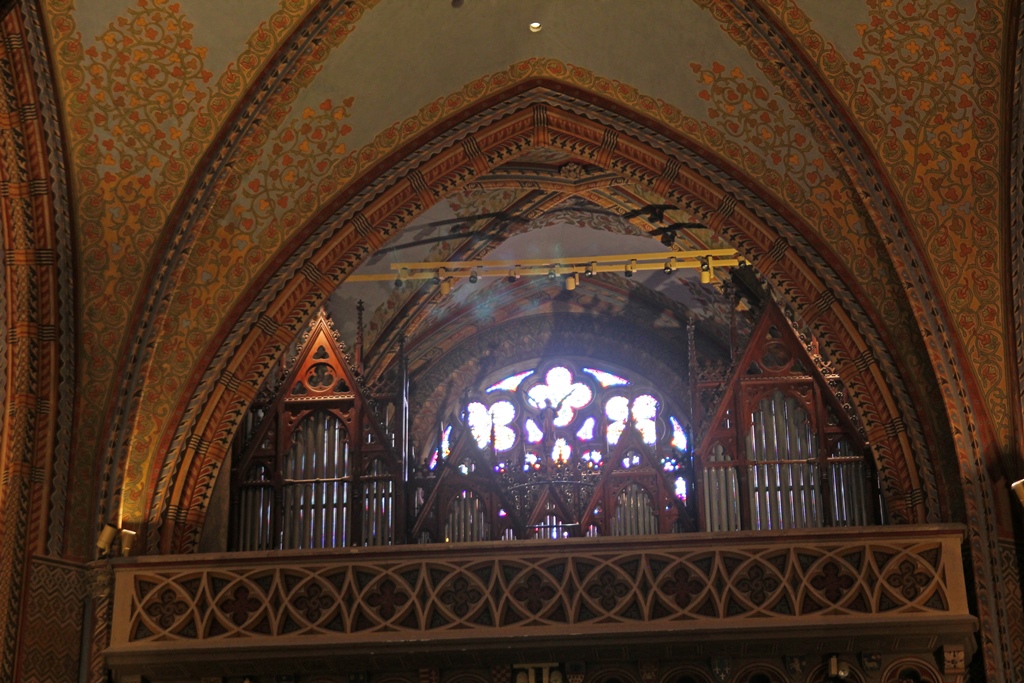
Organ Loft
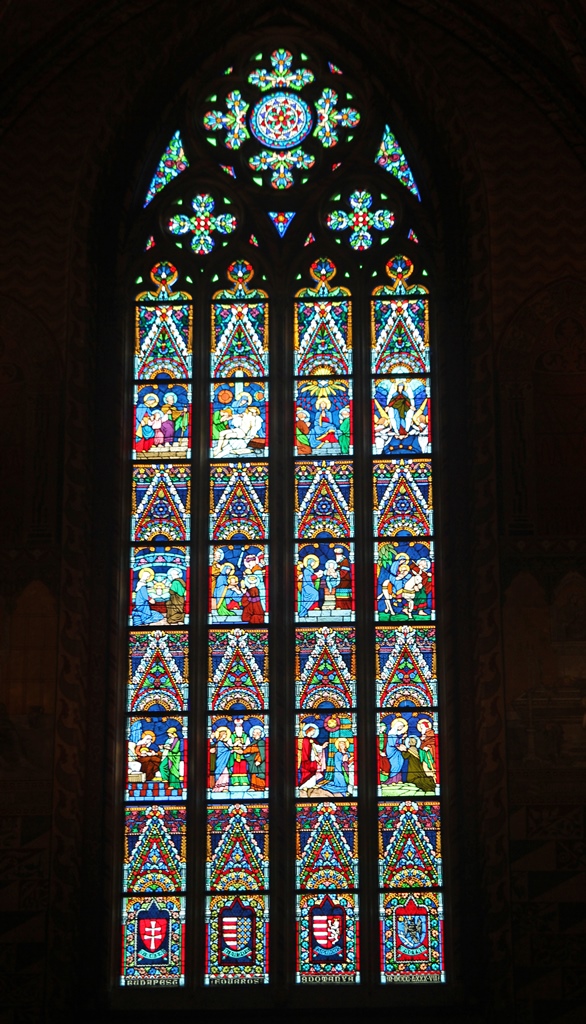
Virgin Mary Window
Just to the left of the Mary Gate, not quite covered by the plastic sheeting, is
a frescoed wall, at the bottom of which a coat of arms can be seen. This is called
the "Shield of Matthias", and it dates back to 1470, which was during the period of
the King Matthias renovation. Matthias was a member of the Hunyadi family, and at
the center of the shield the symbol of the Hunyadi family, a small raven with a
golden ring in its beak, can be seen. Ravens can be found elsewhere in and on the
church by the sharp-eyed. The shield was first affixed to the outside of the
church's large bell tower, and there is still such a shield there today. This
shield is a replica of the original, which is the one inside the church.
Frescoes and Shield of Matthias
The Matthias Shield can be seen as still being attached to the tower, as the wall
where it's displayed is the inner wall of the tower, the part that's enclosed
inside the church. Inside the base of the tower, and entered through a doorway
around the corner from the shield, is the small but popular Loreto Chapel.
Inside the chapel is a Madonna and Child statue with a legend behind it.
According to the story, this statue was venerated in Buda prior to the conquest
by the Turks in 1541, and Christians enclosed it inside a wall to keep it from
being found and desecrated by the Muslims. But when Christian forces returned in
1686, the wall collapsed and the Virgin was revealed to the Muslims inside what
was now a mosque, causing them to be demoralized and leading to their surrender.
There are those who have expressed doubt regarding some aspects of this story,
but it remains a good story.
Fresco Above Loreto Chapel
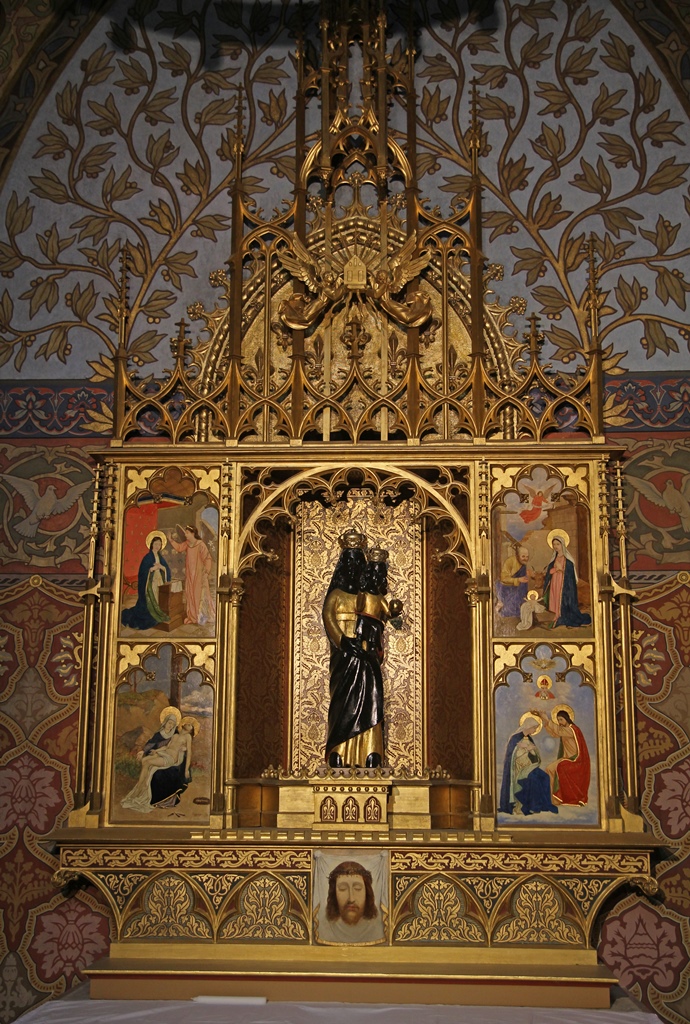
Altar, Loreto Chapel
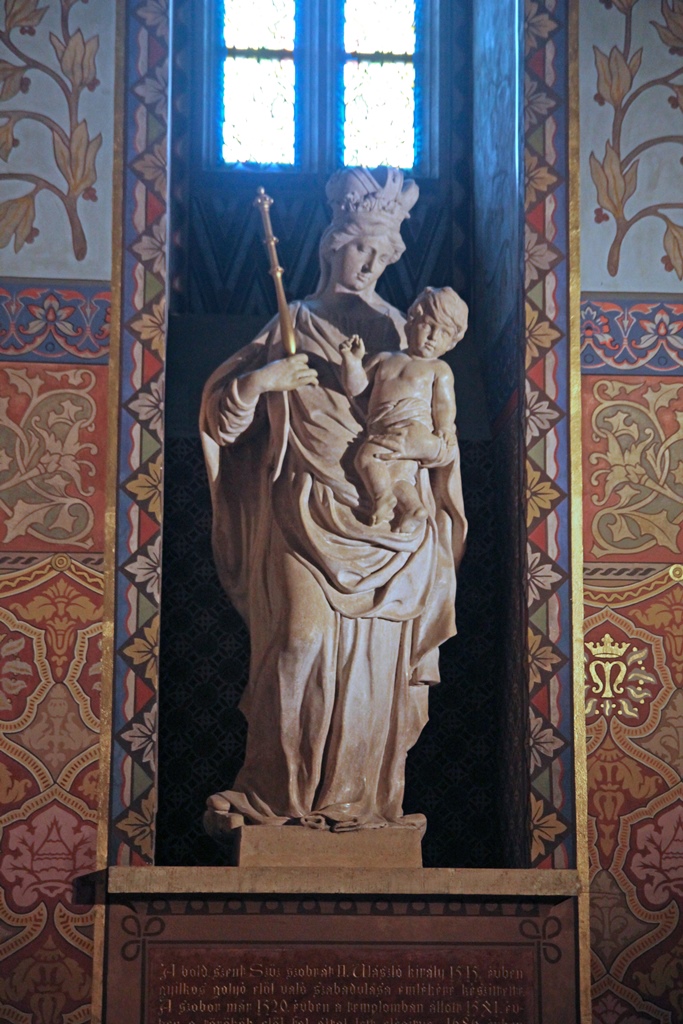
Madonna and Child, Loreto Chapel
Continuing northward from the Loreto Chapel, one first passes the main entrance
doors for the church (this is not the tourist entrance), which were locked during
our visit.
Main Entrance
Just past the doors there is a small area beneath the church's smaller tower
(called the Béla Tower) with a few interesting features. One is the baptismal font,
located in the middle of this area. Another is a fresco depicting elements of the
Siege of Nándorfehérvár, also called the Battle of Belgrade, a 1456 battle at
Belgrade in which the Turks were repulsed, at the time stabilizing the border
between the Kingdom of Hungary and the Ottoman Empire. The main Hungarian commander
was John Hunyadi, the father of the eventual King Matthias. During the siege, it's
said that Pope Callixtus III (depicted in the fresco) had all of the churches in
Christendom ring their bells at noon to call Christians to pray for the Hungarians
defending the faith. It's also said that this was the beginning of the custom
(continued until the present day) for all churches to ring their bells at noon.
Baptismal Font and Window
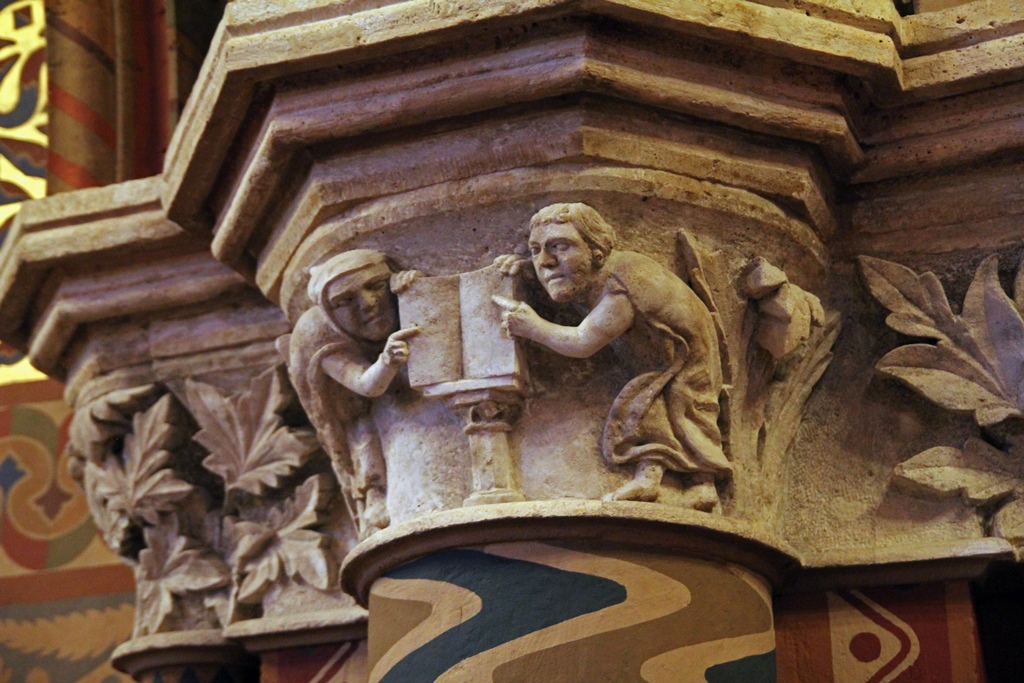
Column Near Baptismal Font
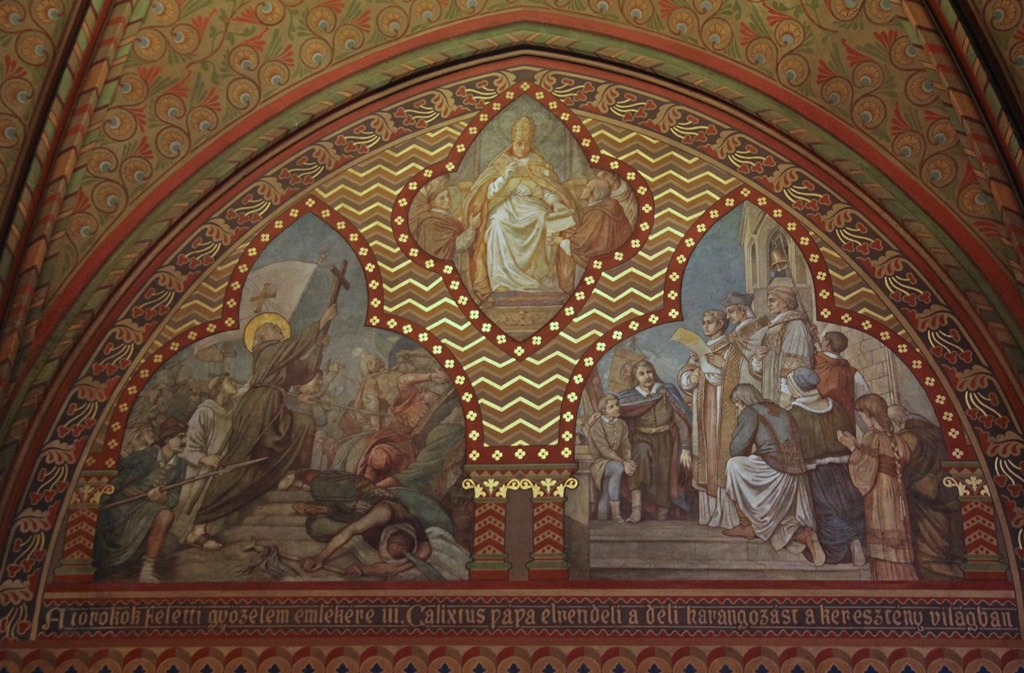
Fresco of the Victory at Nándorfehérvár
Probably the most distinctive feature of this corner of the church is its window,
which represents a creative solution by the architect Schulek to the problem of
the center of the wall arch above the baptismal font not coinciding with the
center of the exterior wall between the door and the edge of the church. His
solution was to center this window (which depicts the Lamb of God) in the outer
wall section, and on the interior wall to enclose it in a set of expanding
circles which end in a large circle centered in the arch.
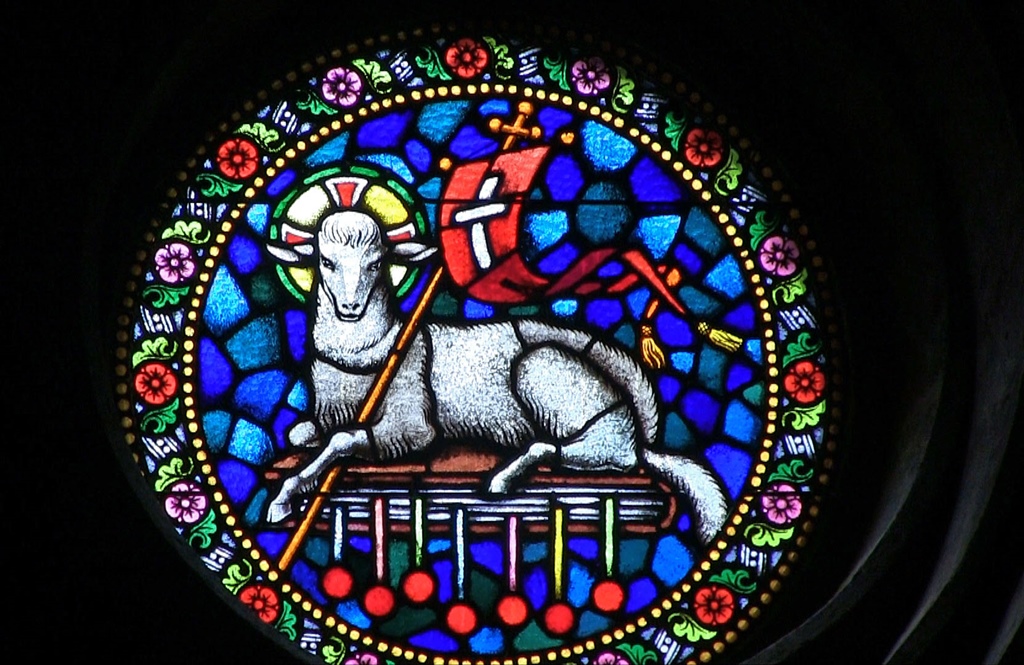
Window Above Baptismal Font - "Lamb of God"

Inside Matthias Church
Like other Catholic churches, the Matthias Church houses a number of chapels for
specialized worship, mainly of individual saints. Since the church is not very
large, neither are the chapels, nor are they as numerous as they might be in a large
cathedral. But there are a few of them along the churches north wall. Starting
from the back of the church, the first chapel is devoted to St. Imre (also known as
St. Emeric), the son of Hungary's first king, St. Stephen. Some discussion of St.
Emeric can be found on the St. István's Basilica page.
Altar, St. Imre Chapel
The next chapel is the Béla Chapel, which holds a tomb containing the actual
remains of King Béla III (1172-96) and his first wife, Agnes of Antioch. The
fact that these remains are relatively intact is a rarity. By tradition, most
of the early Hungarian monarchs were buried in the Basilica in the city of
Székesfehérvár, 30 miles or so to the southwest of Budapest. When the Turks
conquered Hungary, they tossed out all the royal remains they found in
Székesfehérvár, except for those of Béla. Béla was probably treated with more
respect, as he had spent time in the Byzantine capital of Constantinople and
had actually participated in campaigns against Hungary before returning to
Hungary to claim the throne in 1172 (on the death of his older brother,
Stephen III). Béla and Agnes were moved to the Matthias Church in 1898.
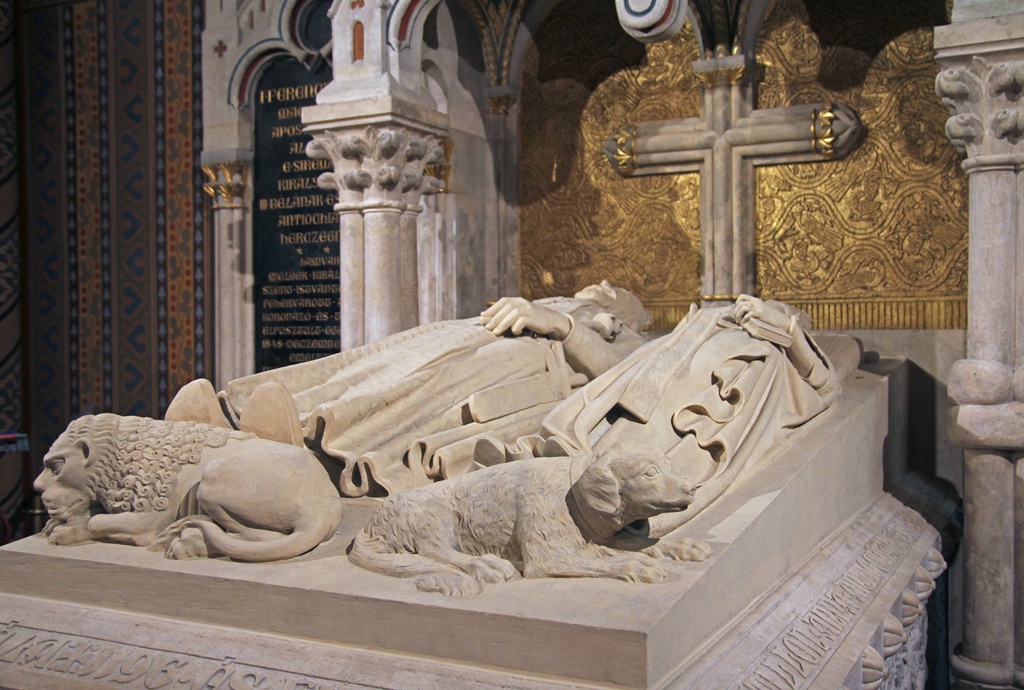
Tomb of Béla III and Agnes of Antioch
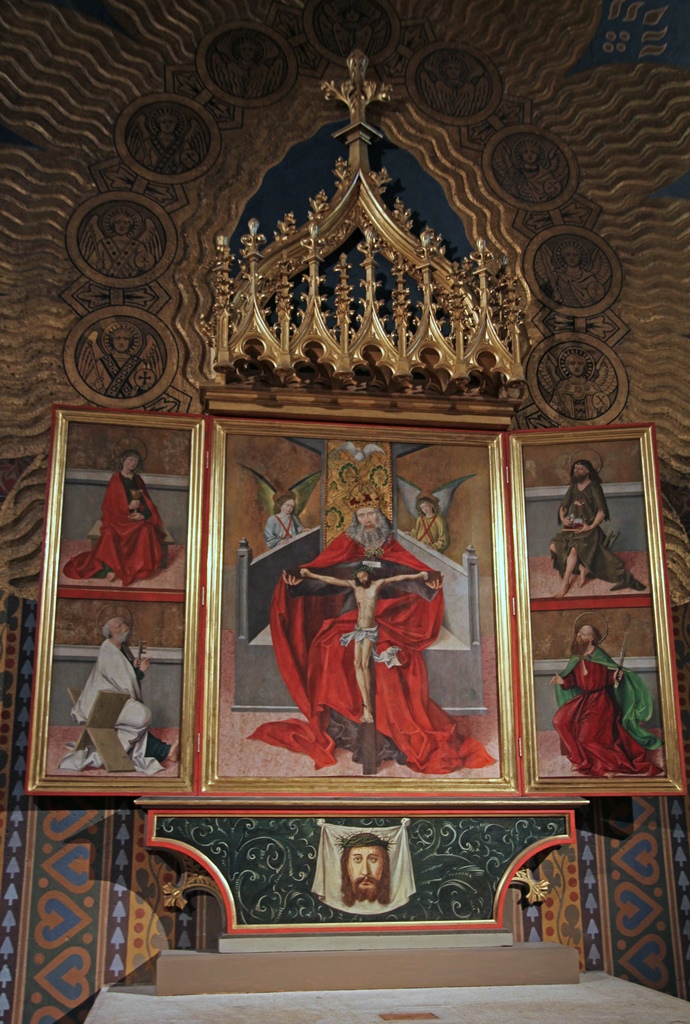
Altar, Béla Chapel
The next chapel, to the left of the main altar area, is devoted to St. László,
who reigned in Hungary from 1077 to 1095. His tomb was originally in the city
of Nagyvárad, and numerous miraculous events associated with the tomb are said
to have happened there. But the miracles didn't extend to protecting the tomb
from the Turks, who pretty much trashed it. However, part of László's skull
somehow survived and found its way to the city of Gyor, located about 60 miles
west of Budapest, where it is kept to this day in a reliquary in the cathedral.
The St. László chapel in the Matthias Church displays a replica of this
reliquary on its altar, as well as frescoes of scenes from his life.
St. László Chapel
The last chapel in the northeast corner of the church is the
beautifully-decorated St. Stephen Chapel, which has seven frescoes of St.
Stephen and 12 windows depicting other Hungarian saints. The altar was
designed to hold the reliquary of St. Steven's right hand, but this
turned out to be wishful thinking. The relic was instead mostly kept in
Buda Castle since it was acquired in the 18th Century, and while it
travelled around a bit (ending up in St. István's Basilica as of 1950),
it never made a stop in the Matthias Church. But the St. Stephen Chapel
did temporarily serve as home to maybe the most important relic of all,
the Holy Crown of Hungary. In 1916, around the time of the coronation of
Charles IV, the crown needed to be kept somewhere secure in the church,
as this was to be the location of the coronation. The St. Stephen Chapel
was chosen to serve this purpose.
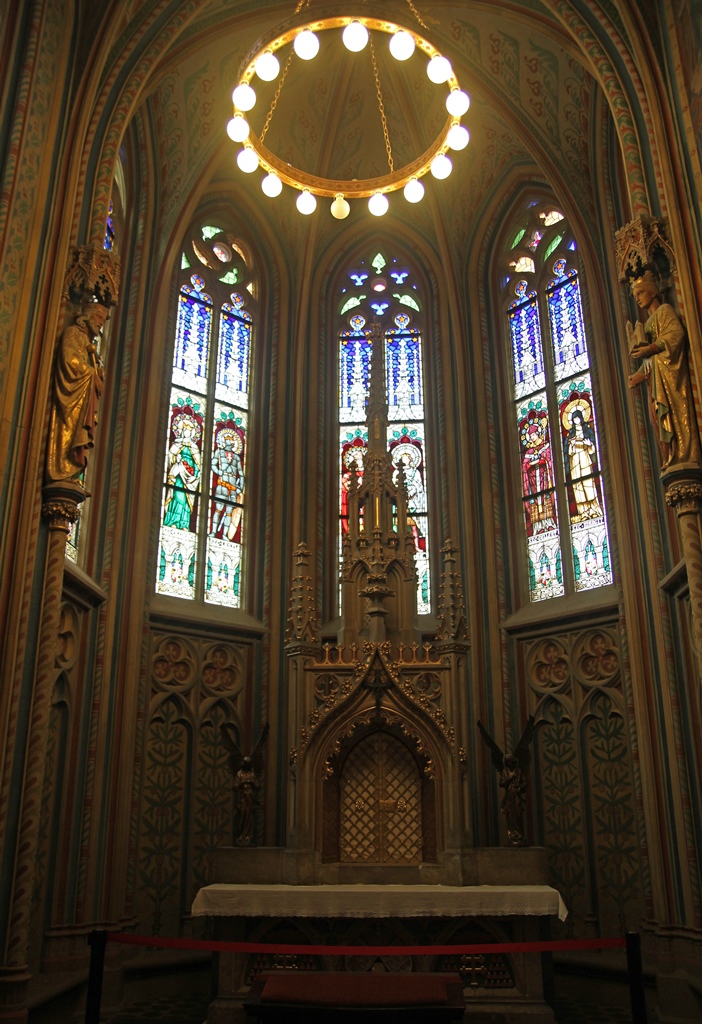
St. Stephen Chapel
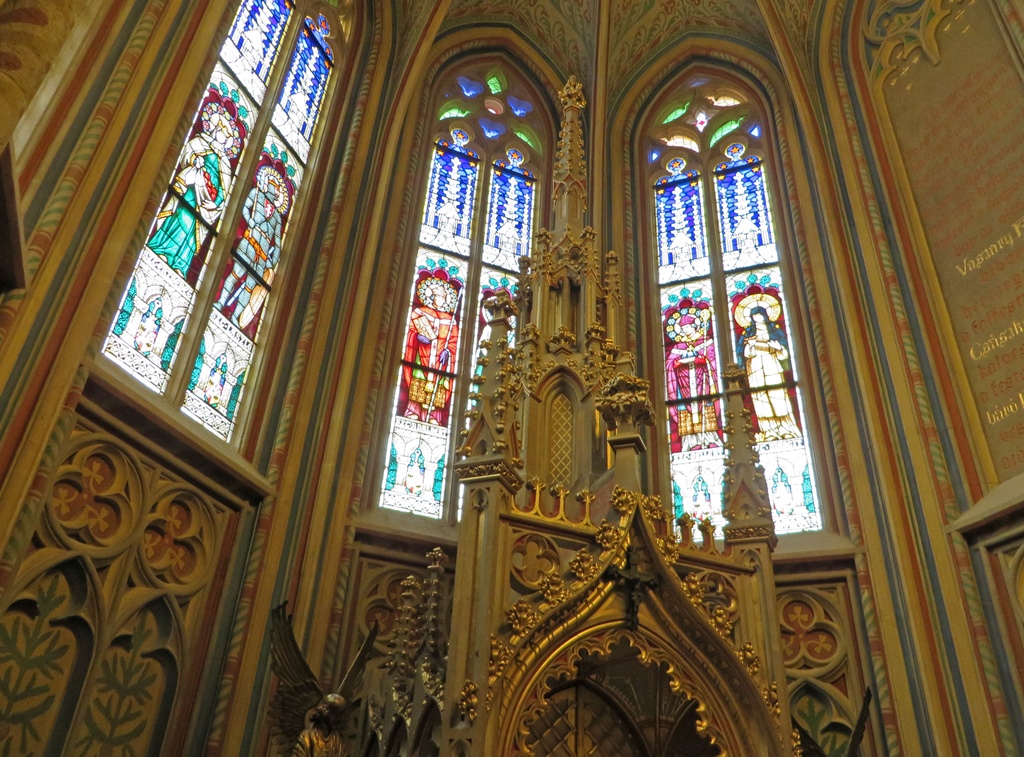
Altar and Windows, St. Stephen Chapel
In front of the St. Stephen Chapel there is a small room with a spiral staircase
that leads up to a sort of balcony, called the Royal Oratory, which overlooks
the church's main altar area. The idea was that the royal couple could enter
the church through the small room (known as the Royal Gate), go up the stairs
and observe services from the Oratory. There is definitely a nice view from the
Oratory.
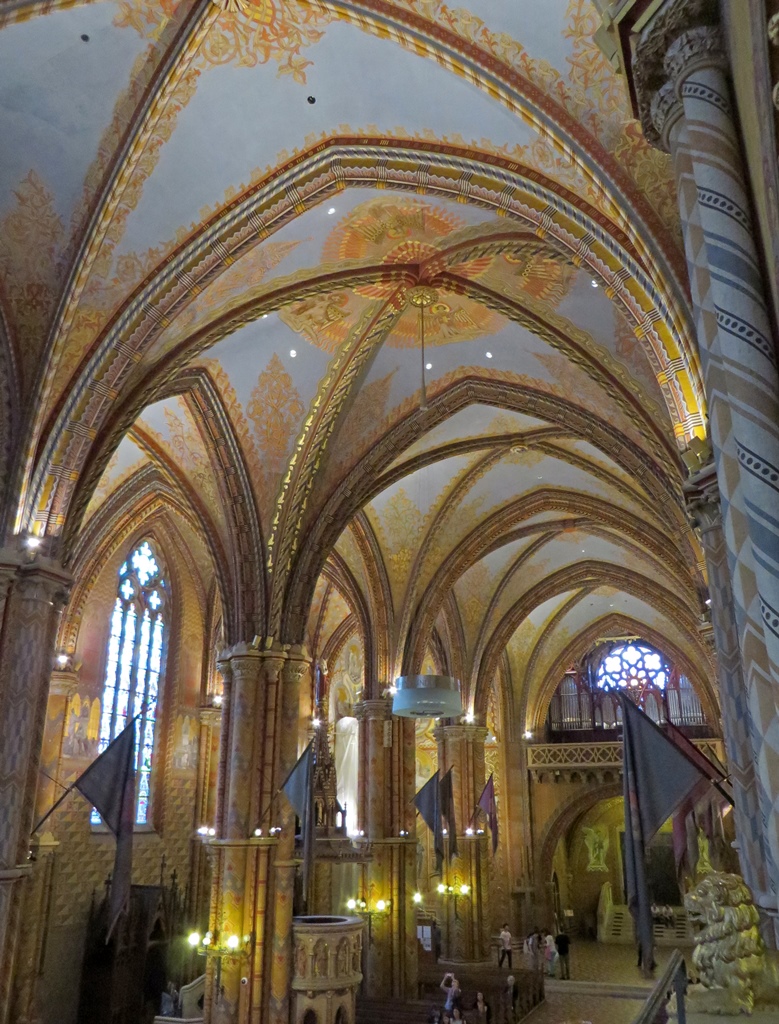
Church from Oratory
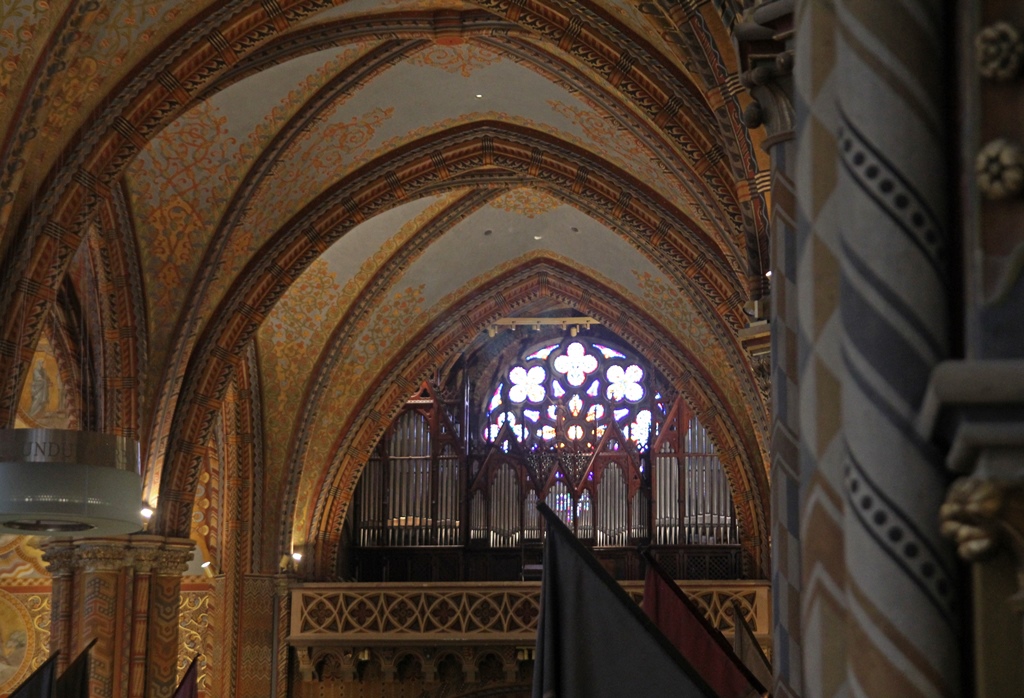
Organ Loft
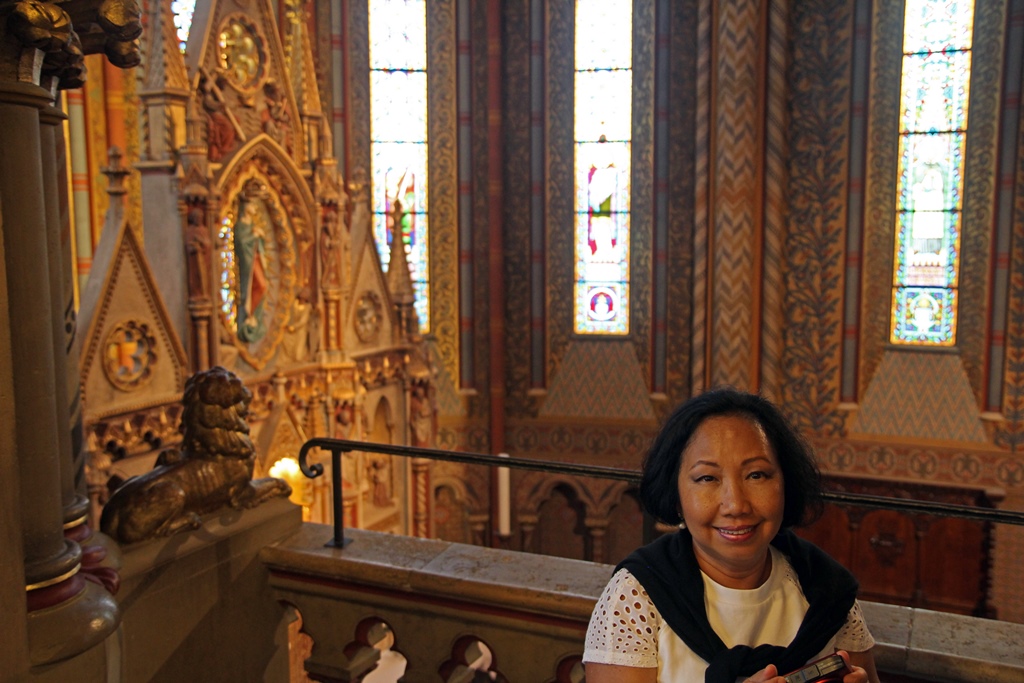
Nella in Oratory
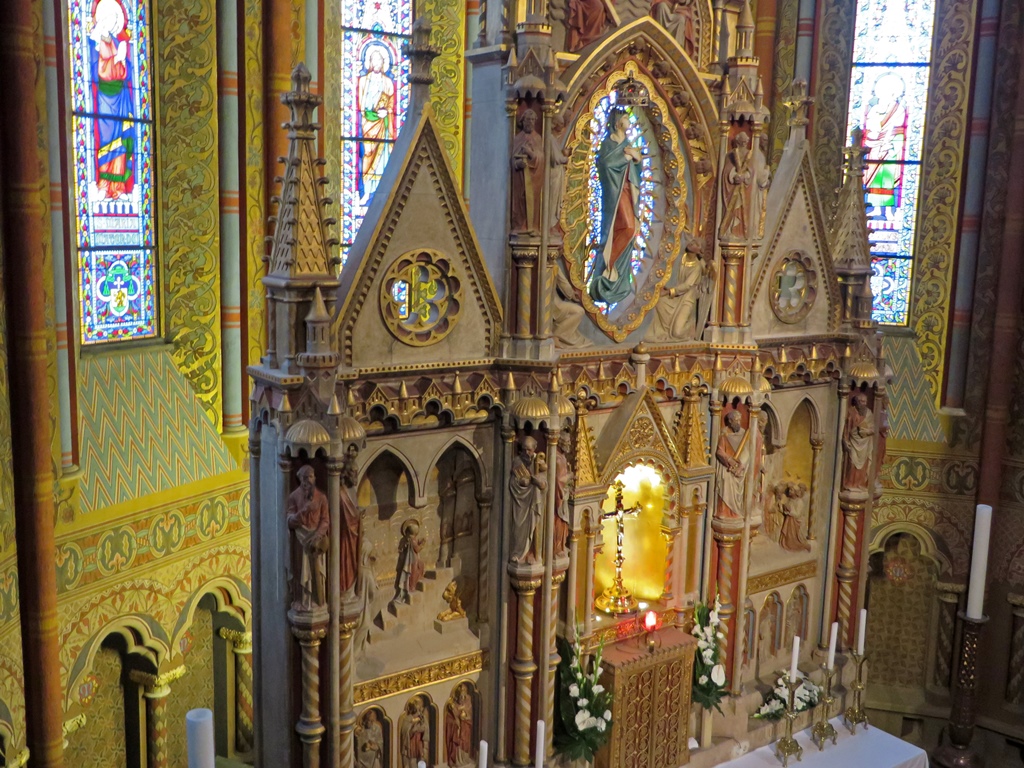
Main Altar from Oratory
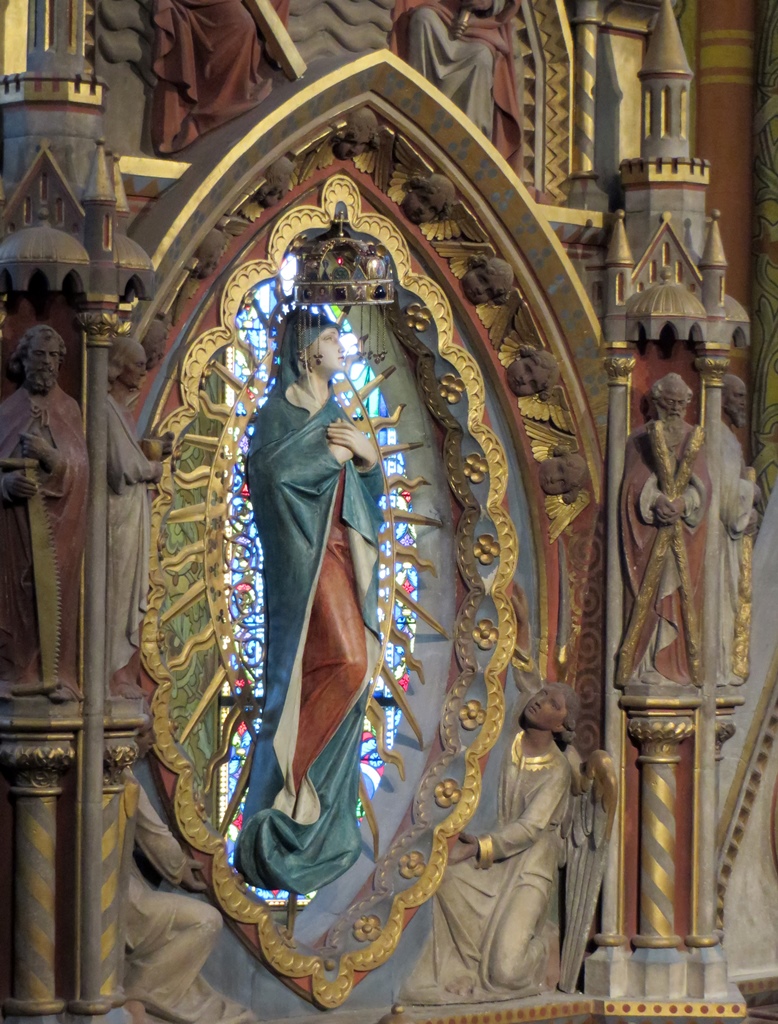
Detail, Main Altar
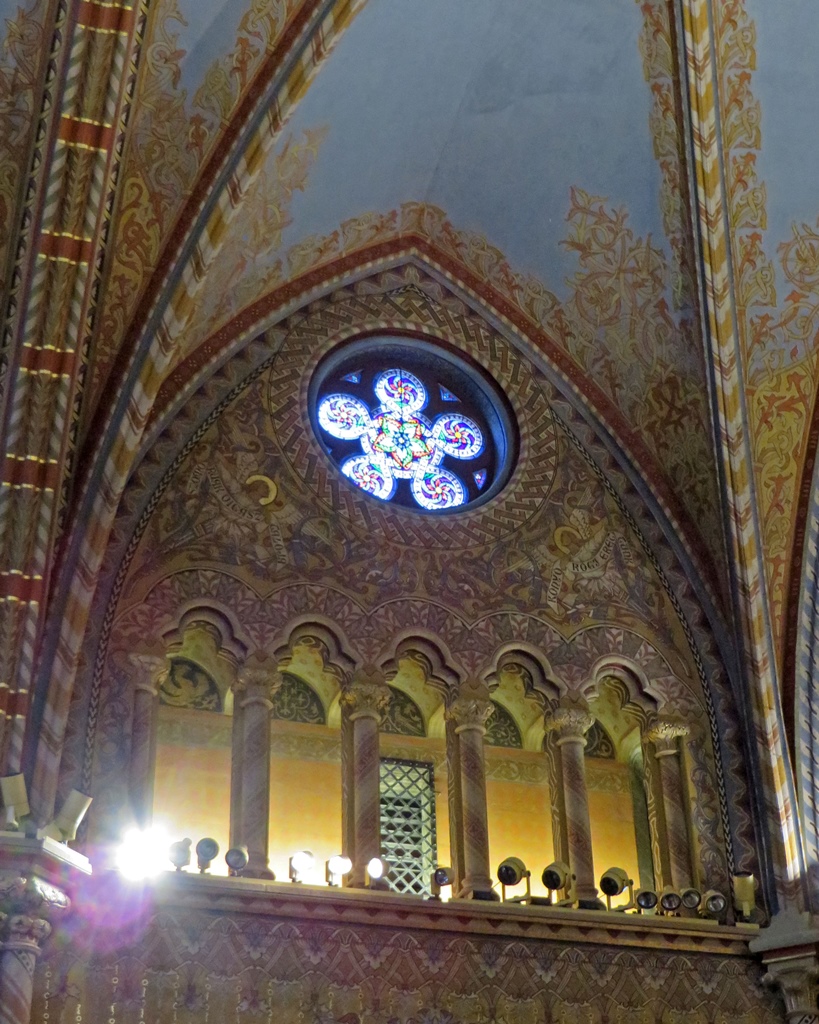
Balcony Across from Oratory
At present the Oratory serves as a sort of small museum. On display are some
vestments from the 18th and 19th Centuries, and what looks to be the Holy Crown
of Hungary, complete with orb, scepter and crooked cross. But those of you who
have been keeping track know that the crown, scepter and orb are in the
Hungarian Parliament building.
The Matthias Church crown jewels are replicas of the originals, created in 1966
while the originals were being kept in the United States. The replicas are
somewhat inaccurate, as they were based on pre-war photographs, rather than on
close examination of the original objects.
White and Gold Brocade Chasuble
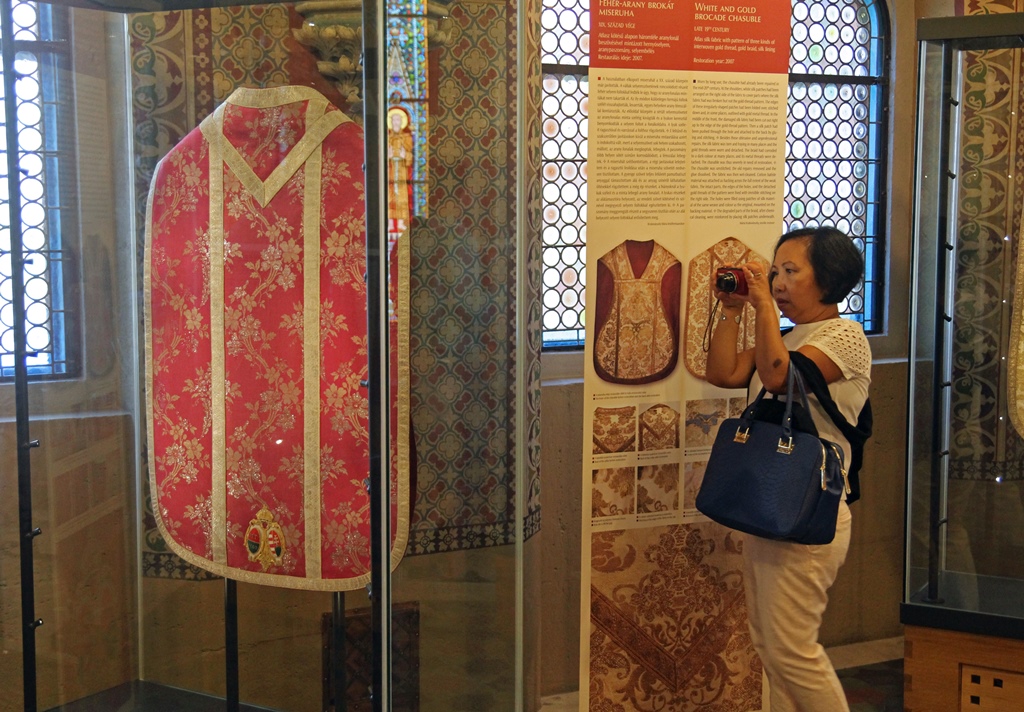
Nella and Maria Theresa Chasuble
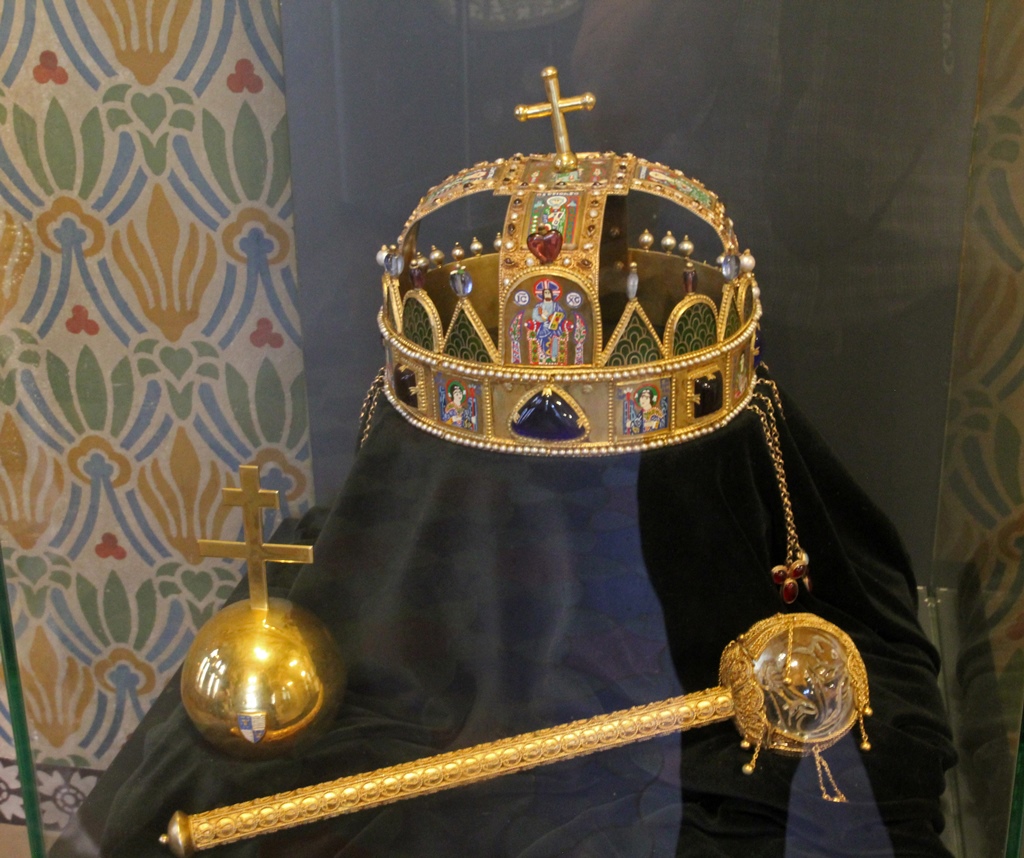
Replicas of Holy Crown, Sceptre and Orb
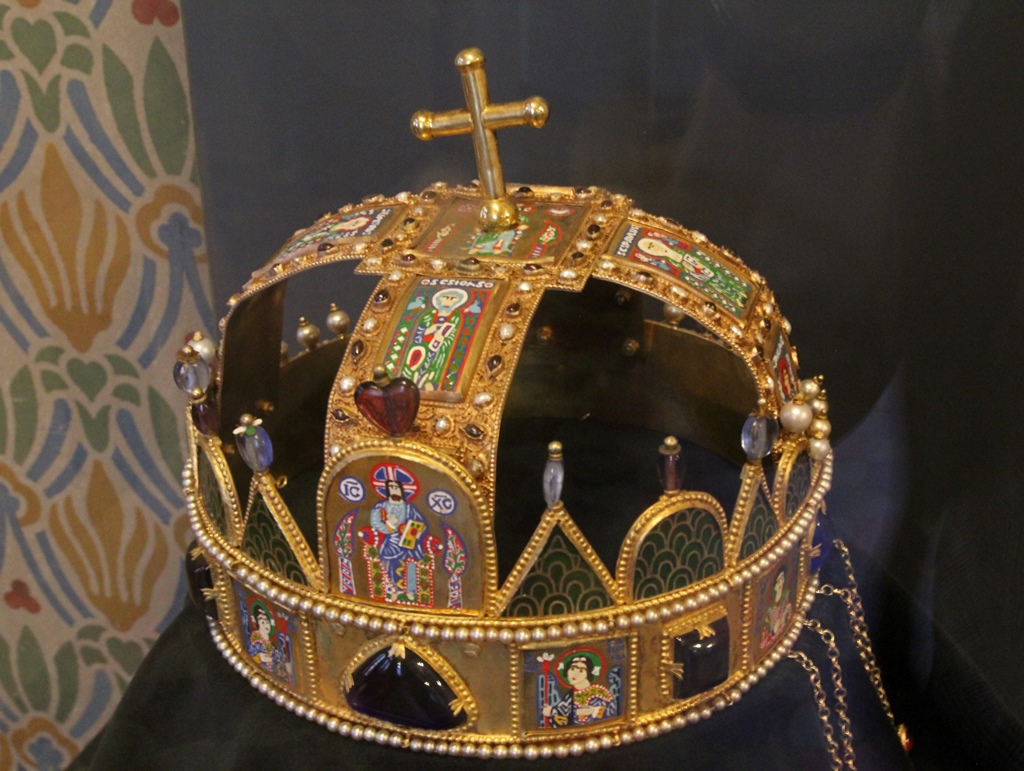
Replica of Holy Crown
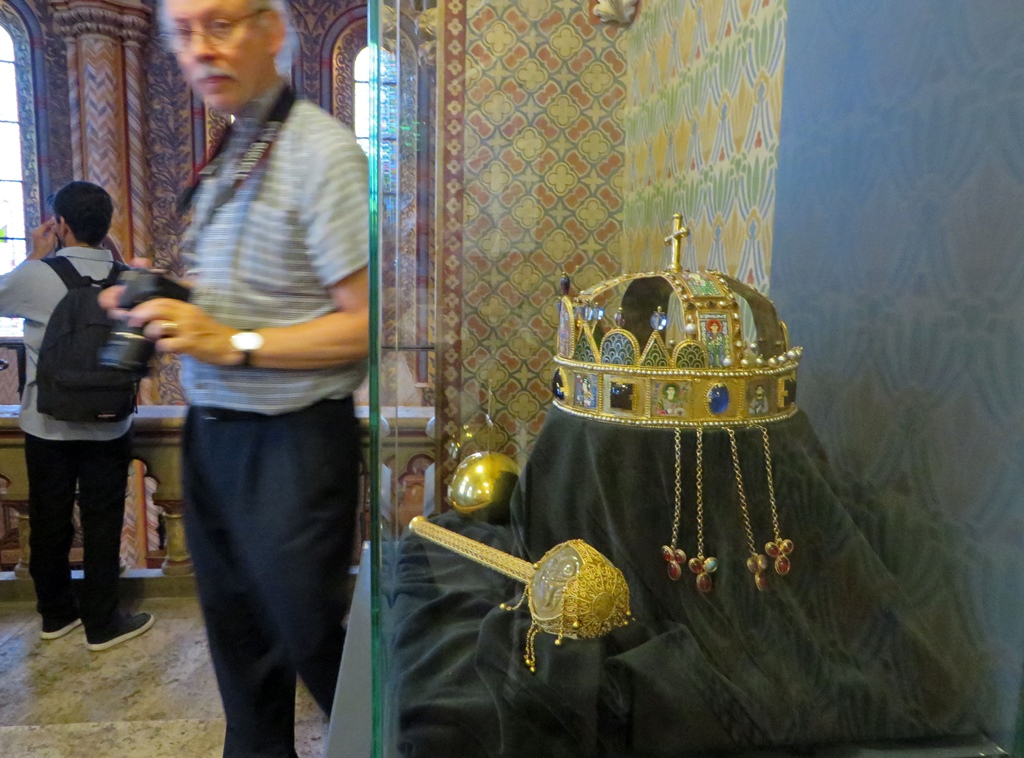
Bob with Replicas of Royal Hardware
Back downstairs, between the Royal Gate and the Béla Chapel, is the Maltese Knight
Chamber, in which are displayed several shields of prominent members of the Order
of Maltese Knights. Also found here are a nice stained-glass window, a statue of
the popular Empress Elisabeth, and a staircase up to a loft area.
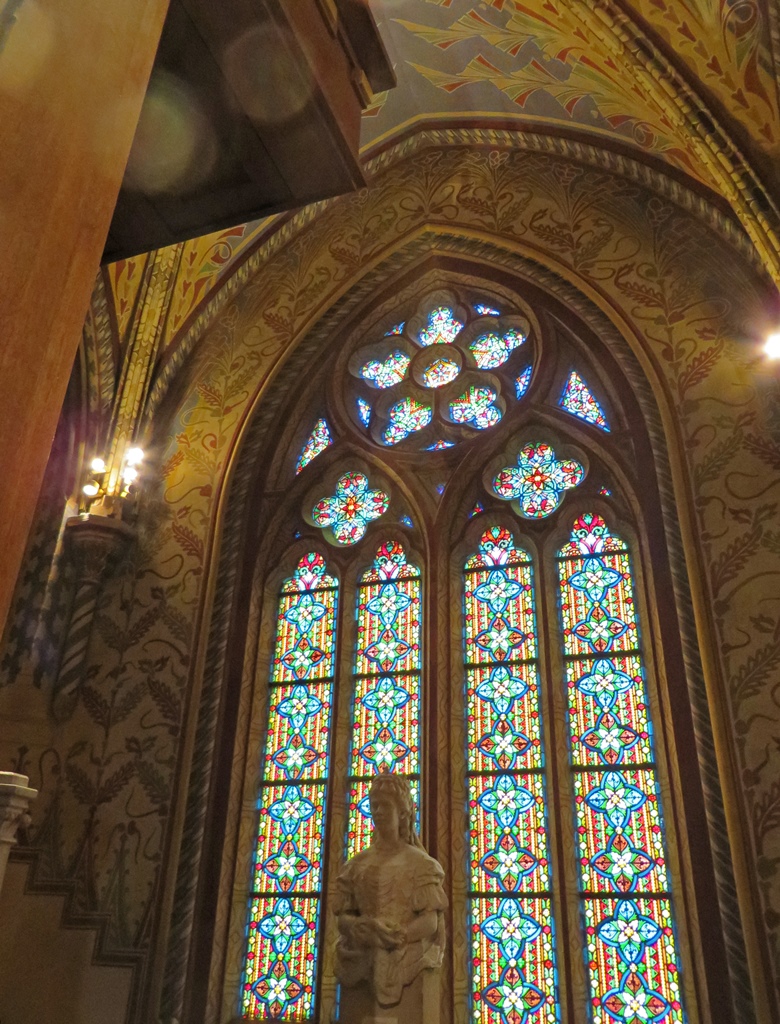
Window and Elisabeth Statue
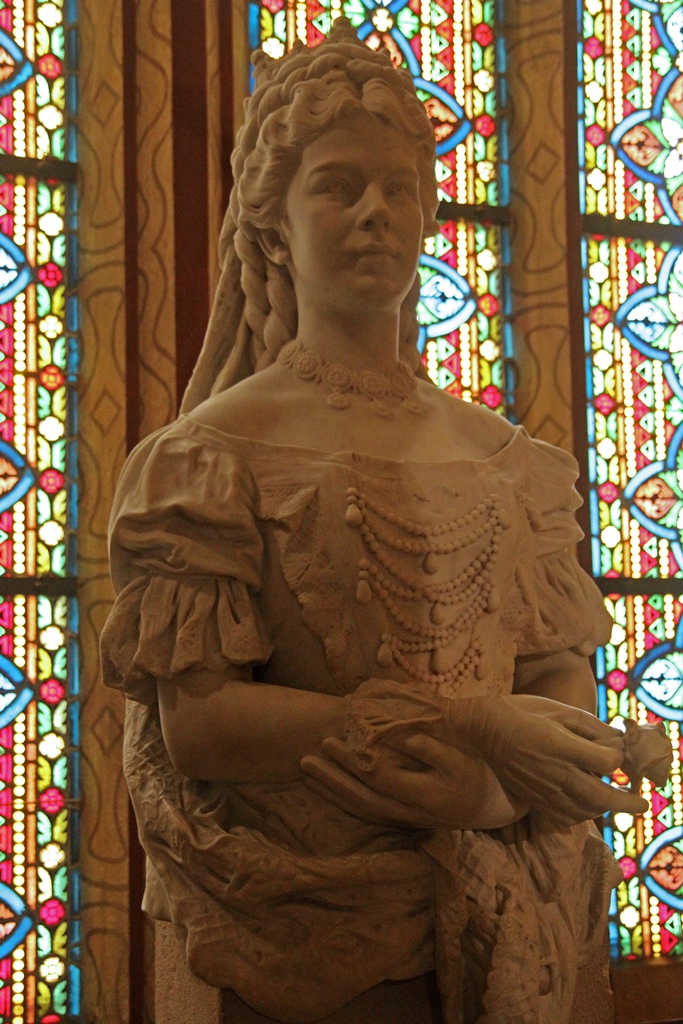
Statue of Empress Elisabeth
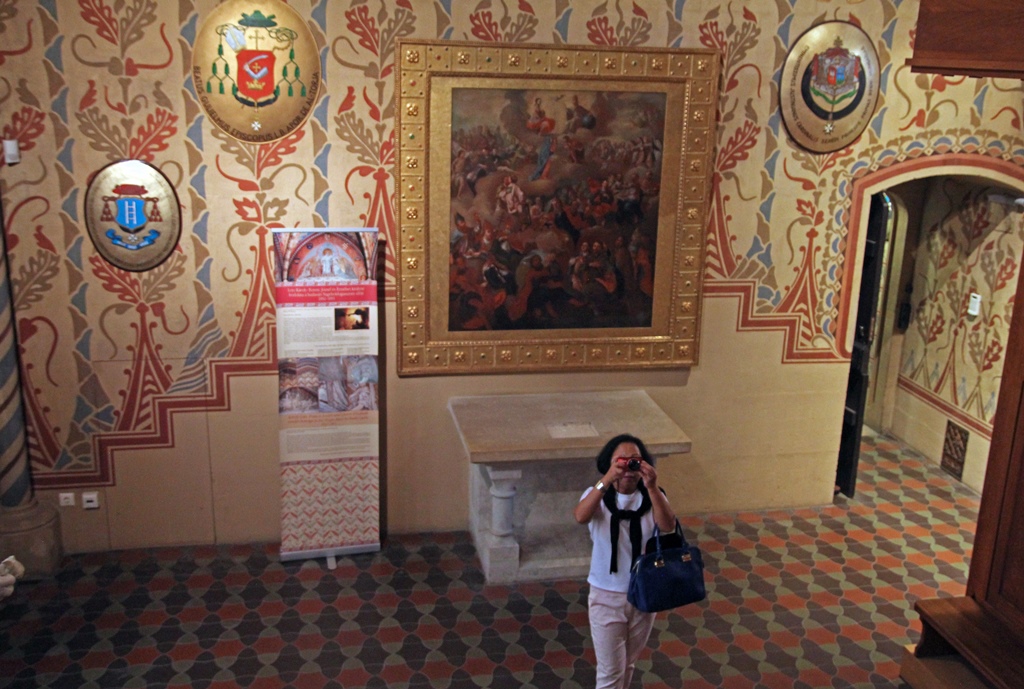
Nella in Maltese Knight Chamber
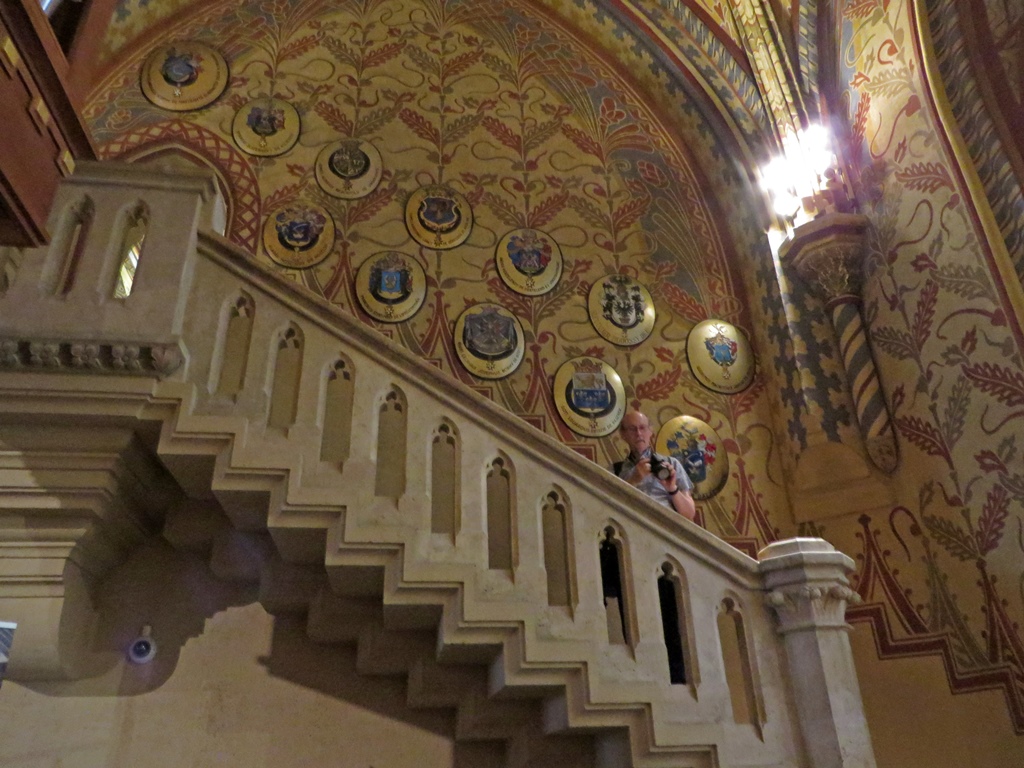
Bob on Stairway, Maltese Knight Chamber
The loft area is an extension of the Oratory museum, with nice but probably
less prestigious objects. As with the Oratory, nice views into the church
below are to be had.
Church from Loft Hallway
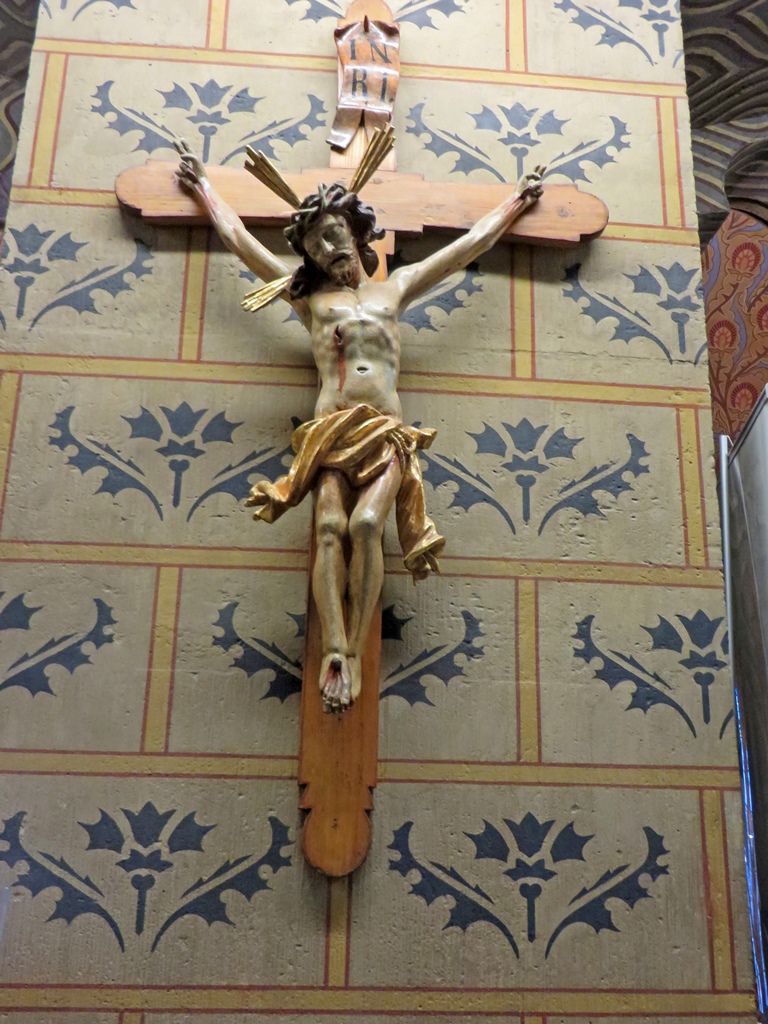
Crucifix, Loft Museum
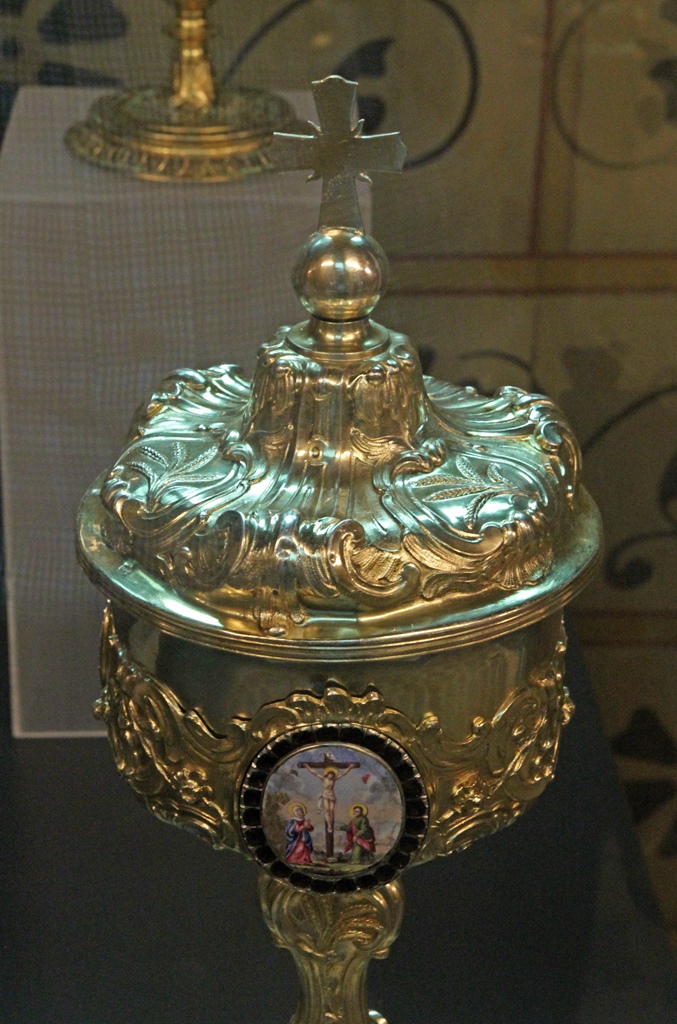
Ciborium (Vienna, 1774)
Last and possibly least, there is a small gift shop in the northwest corner
of the church. As with nearly all European tourist attractions, visitors are
given the chance to purchase mementos of what they've just seen.
Gift Shop
Just past the Matthias Church is a fanciful fortification known as the Fisherman's
Bastion. It was actually built between 1895 and 1902 (according to the plans of
church restoration architect Schulek), and has never been used as any kind of
fortification, a purpose for which it would be ill-suited, especially against
present-day weaponry. And fishermen did not play their trade here. The river is
nearly a quarter of a mile away, so they would have needed to be prodigious
casters, or would have needed really long poles. But there once was a castle
fortification in this area, and the Fishermen's Guild was assigned to man it when
needed. From the bastion one can get a fine look at the church, and also at a
nice 1906 bronze statue of St. Stephen (apparently used as a "pit stop" in season
6 of The Amazing Race) in the area enclosed by the bastion.
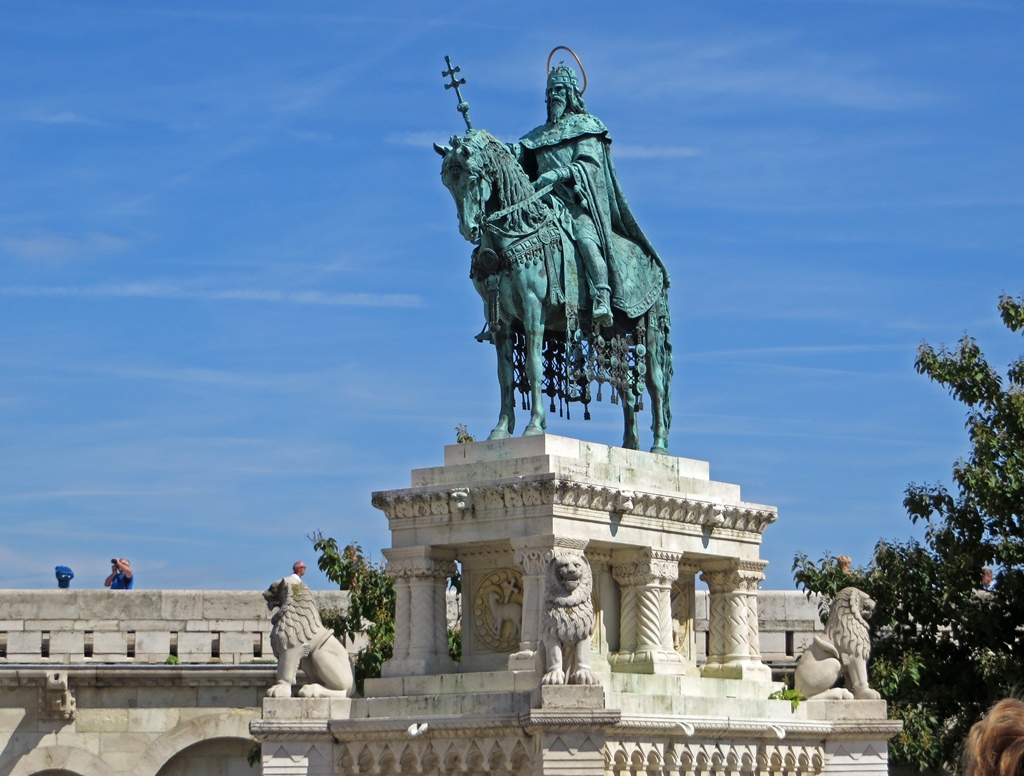
Statue of St. Stephen (1906)
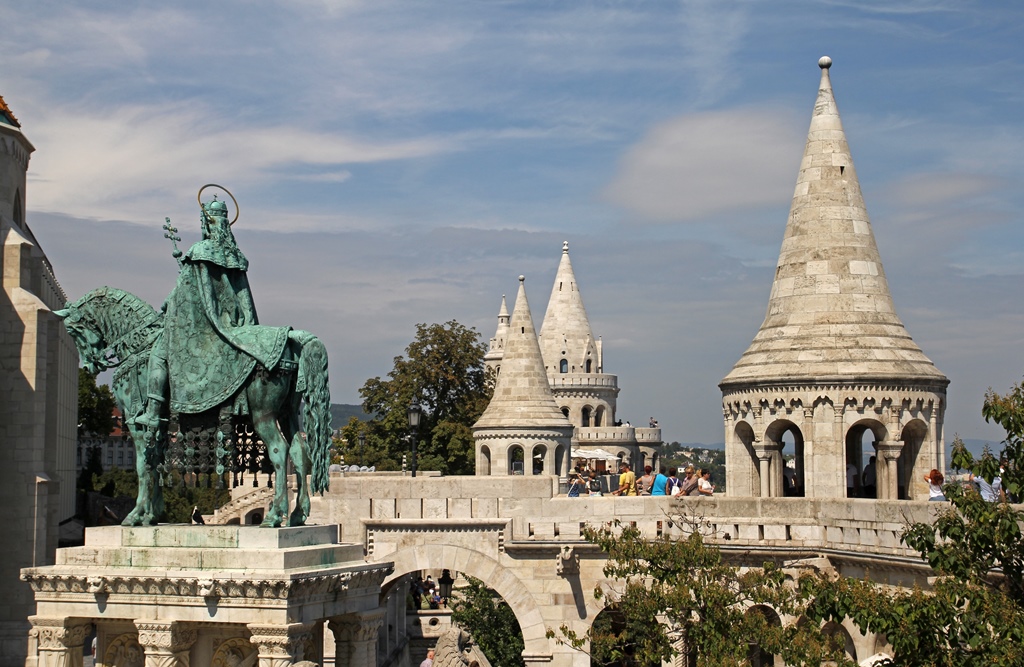
St. Stephen Statue and Fisherman's Bastion
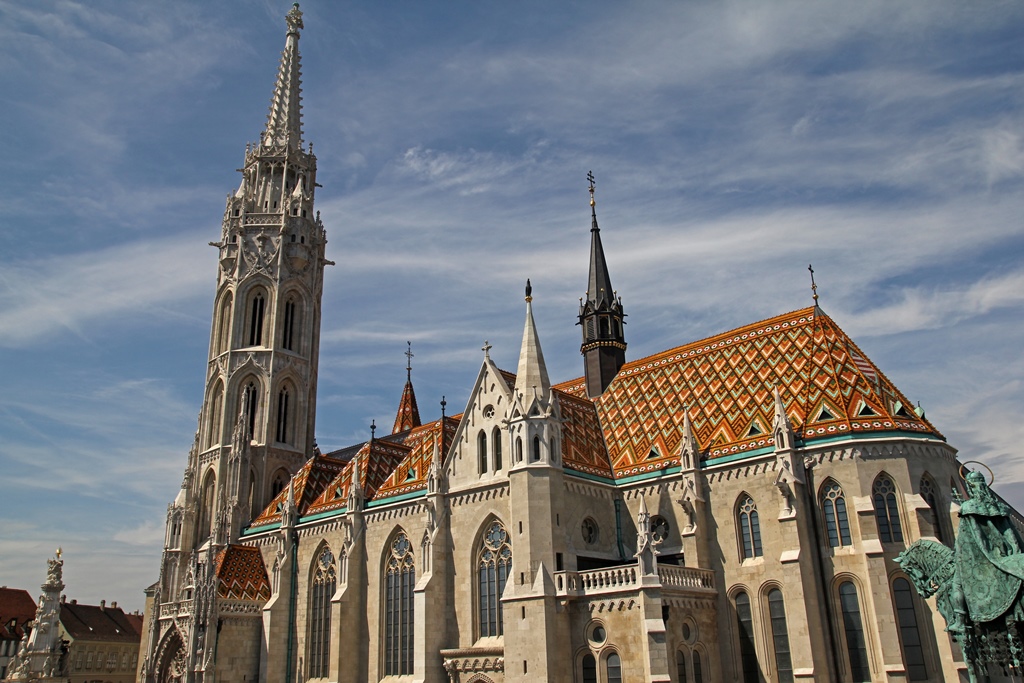
Matthias Church from Fisherman's Bastion
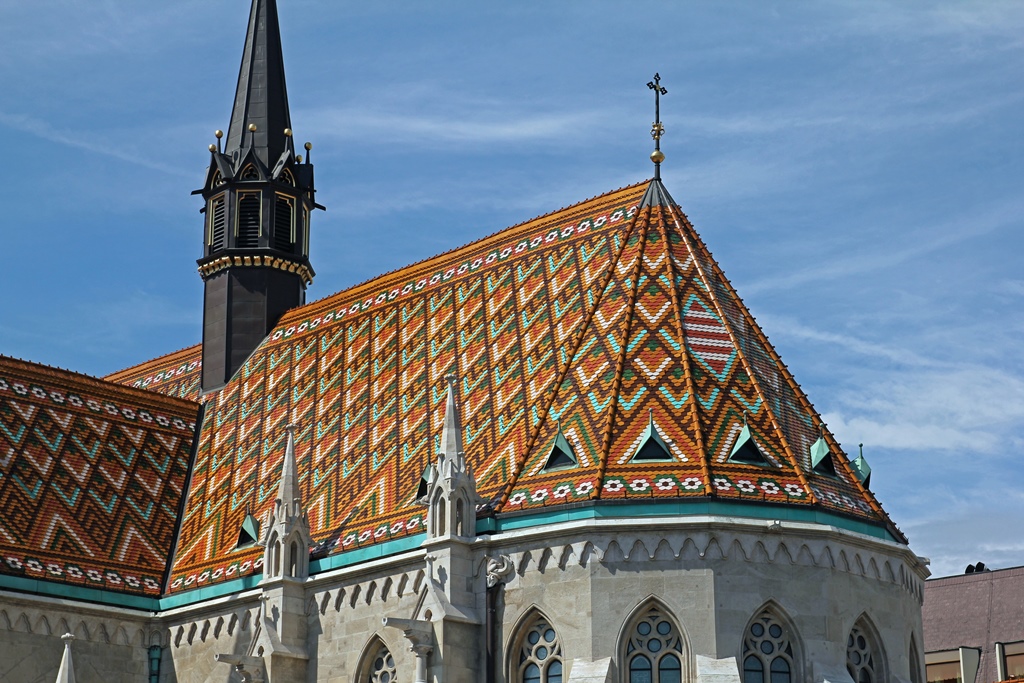
Roof, Matthias Church
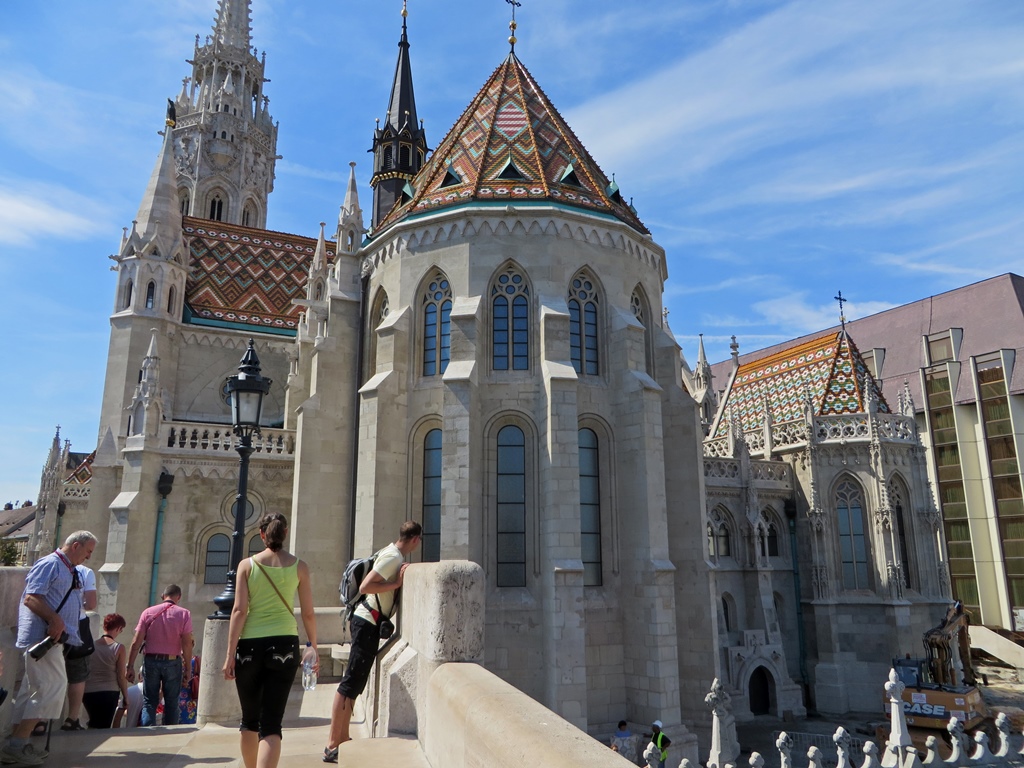
Matthias Church and Tourists
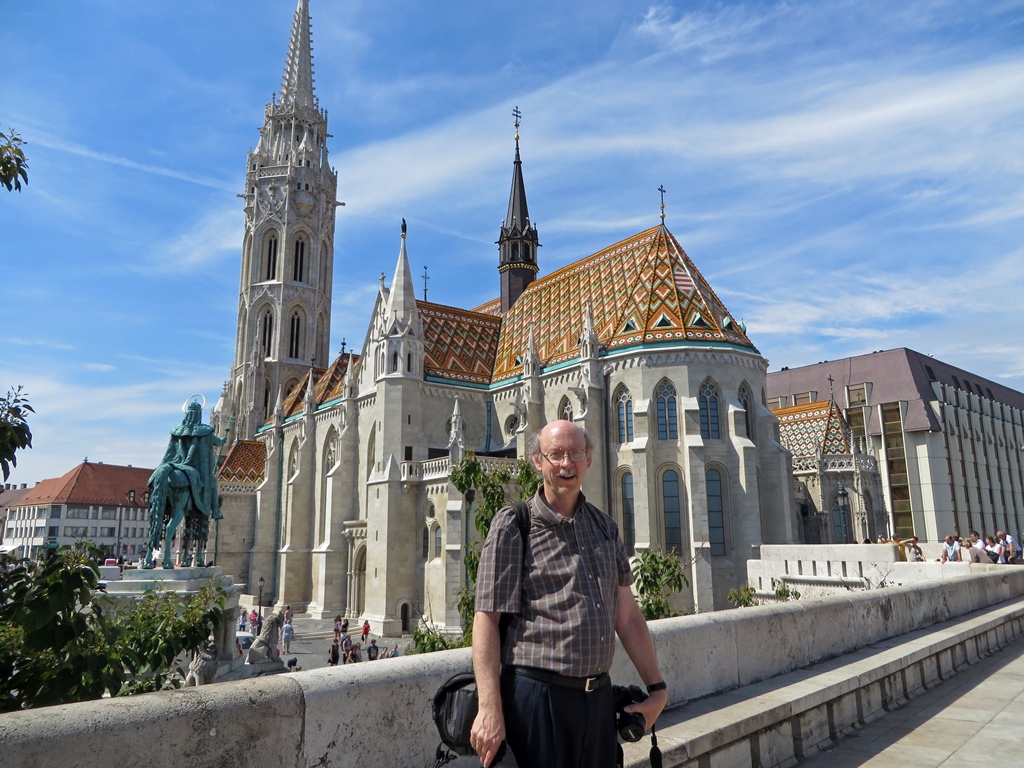
Bob with Matthias Church and St. Stephen Statue
St. Stephen
The Fisherman's Bastion has seven towers, representing the seven Magyar tribes
that settled in the region in 895. There are numerous little windows in the
stonework, and a café in one of the towers.
Fisherman's Bastion
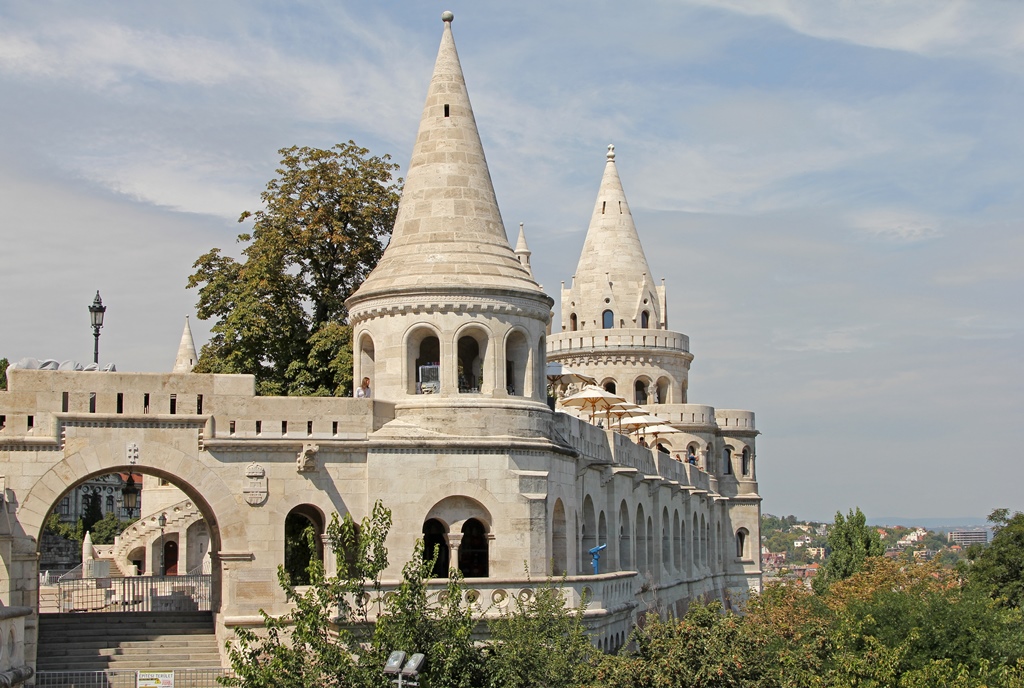
Fisherman's Bastion
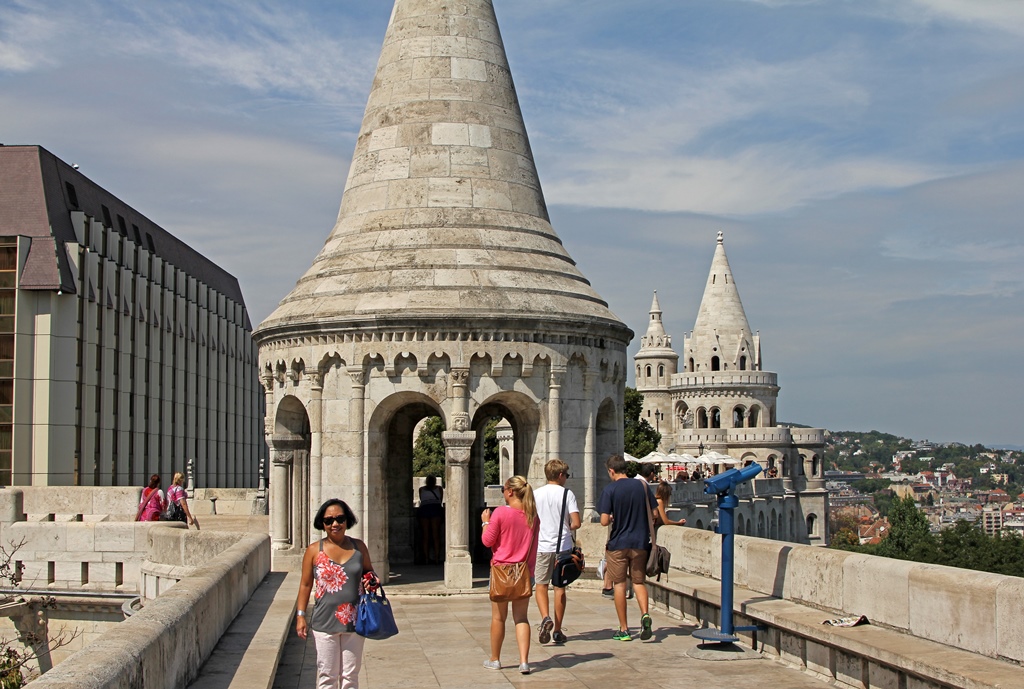
Nella on Fisherman's Bastion
Looking the other way from the Fisherman's Bastion, one can see what is probably
the best view in Budapest, which includes a lengthy stretch of the Danube (from
Margaret Island to the Elisabeth Bridge) and much of the Pest part of the city
on the other side.
Fisherman's Bastion, Parliament and Matthias Church
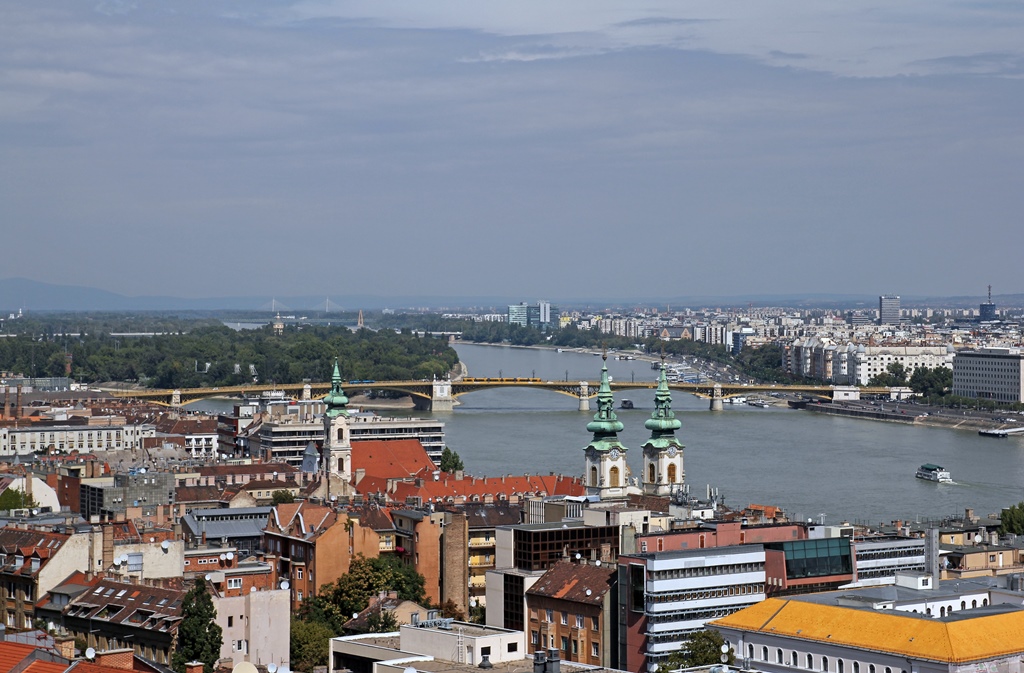
Danube, Margaret Island, St. Anne's Church

Chain Bridge and St. István's Basilica
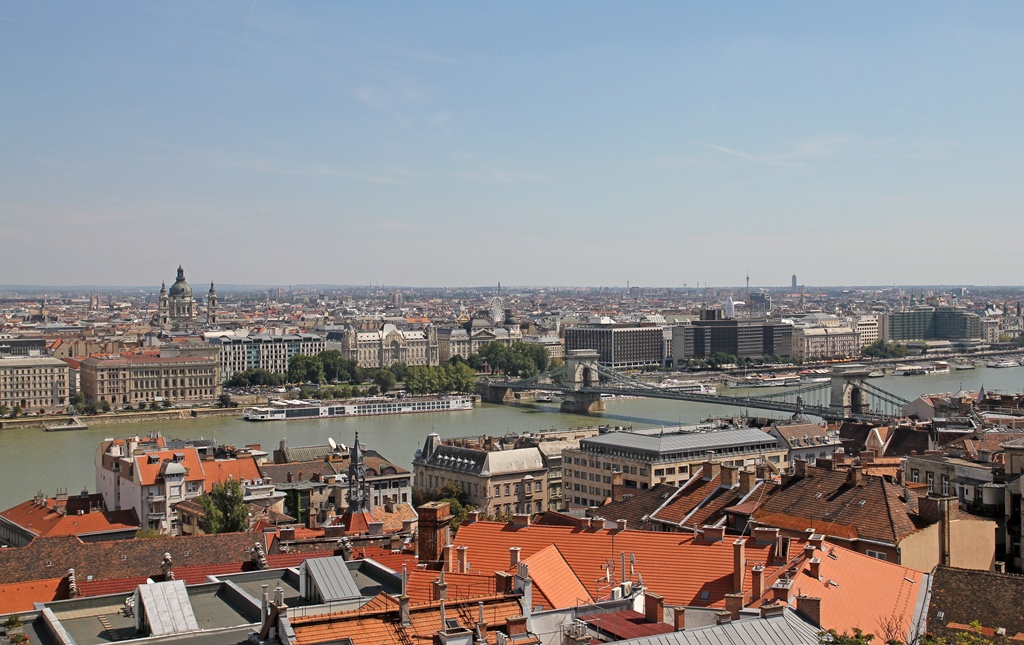
Danube and Chain Bridge
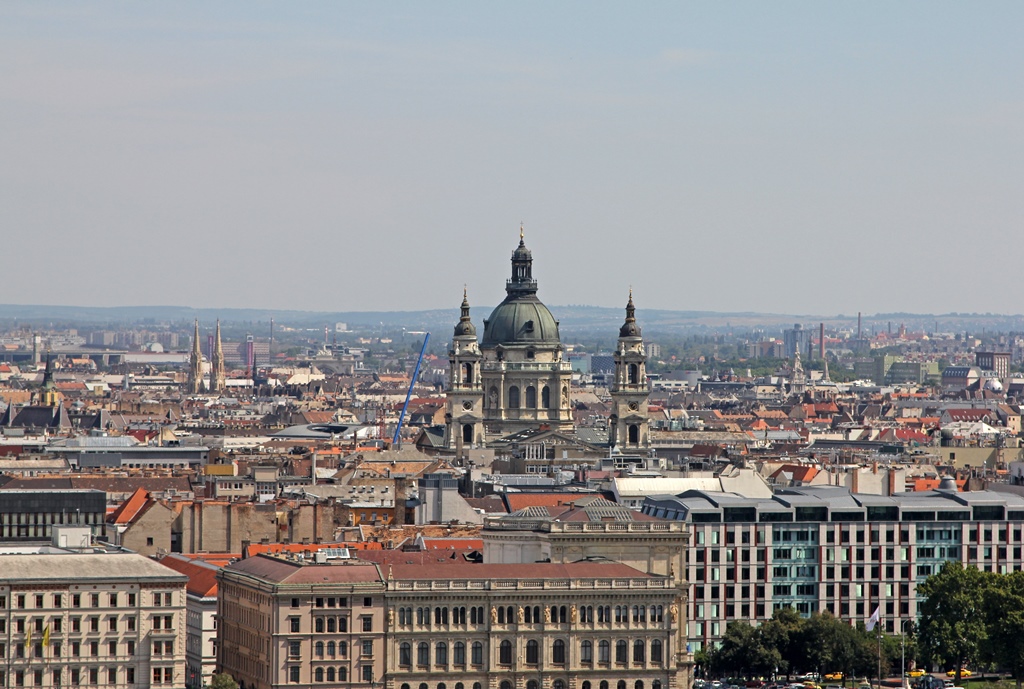
St. Istvan's Basilica
On the downhill side of the Fisherman's Bastion there is a stairway, from the
base of which there is a nice view of the bastion and the Matthias Church.
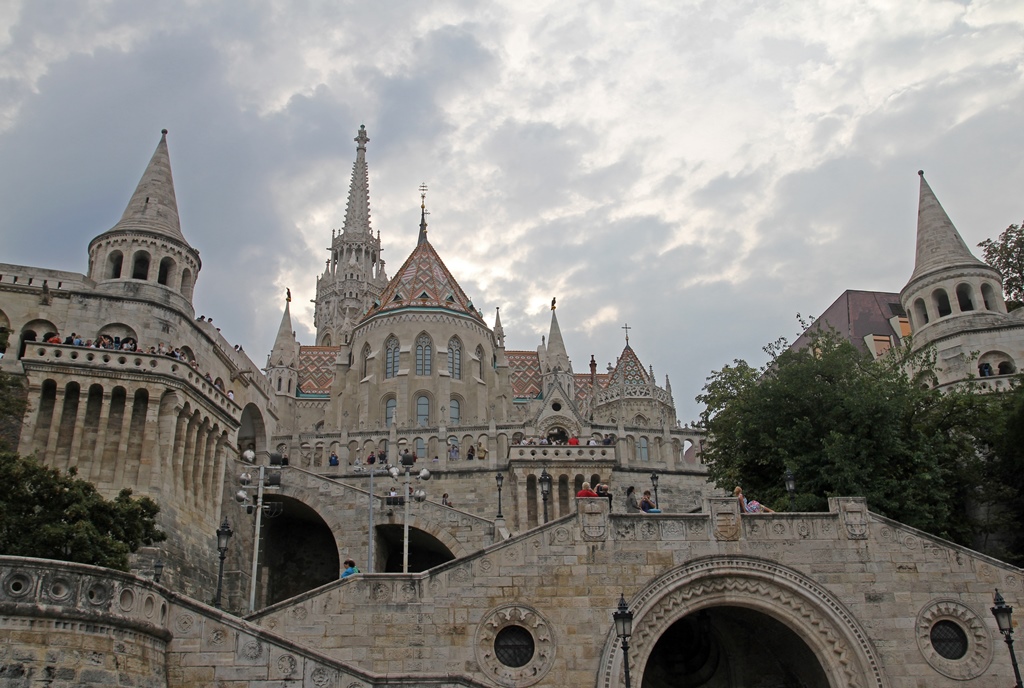
Fisherman's Bastion and Matthias Church
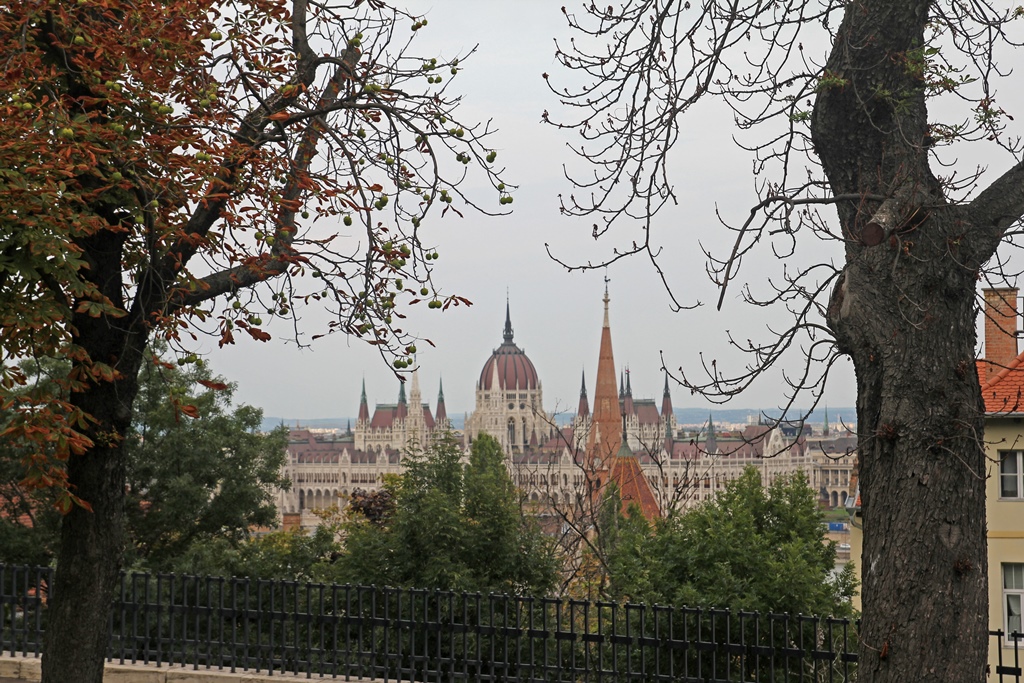
Parliament Building
Our time in Budapest was dwindling – we would be catching a train out of town the
next morning. With the short time we had left, there was one more thing we
wanted to do: we wanted to visit Budapest's famous
New York Café.
This café, located about a half-mile east of the Great Synagogue in Pest, is
found on the ground floor of a building called the New York Palace, now occupied
by the Boscolo Budapest Hotel. The building was opened in 1894 by the New York
Life Insurance Company as an exceptionally classy local head office. As the 20th
Century began, the building's ground-floor coffee house was considered the most
beautiful in Budapest, and was popular with writers, poets and newspaper editors.
It fell into disrepair after World War II, and for a time did duty as a sporting
goods shop. It was reopened as a diminished café in 1954 under the name
Hungária, and continued to suffer from neglect under the communist regime.
In 2001, after the communists were gone, the building was purchased by Boscolo
Hotels, who took the next six years to transform the building into an art
nouveau luxury hotel, also returning the café to its former glory, reopening
both in 2007.
We took the Metro to get to the café, which has a stop nearby. After some
confusion (we entered the building and found ourselves in the hotel lobby; the
café is actually on a lower level), we found the way into the café and were
shown to a table. The café (and the hotel, apparently) was decorated to the
point of sensory overload, with Italian marbles, chandeliers and textiles and
artistic extravagance everywhere. The menu had a selection of food with both
Austrian and Hungarian roots (e.g. goulash, Wienerschnitzel), and some very
high prices. Fortunately we were only there for an afternoon snack, and found
an item featuring a selection of small portions of several desserts which didn't
break our budget too badly. It was all delicious. Nothing at all seemed to be
related to New York.
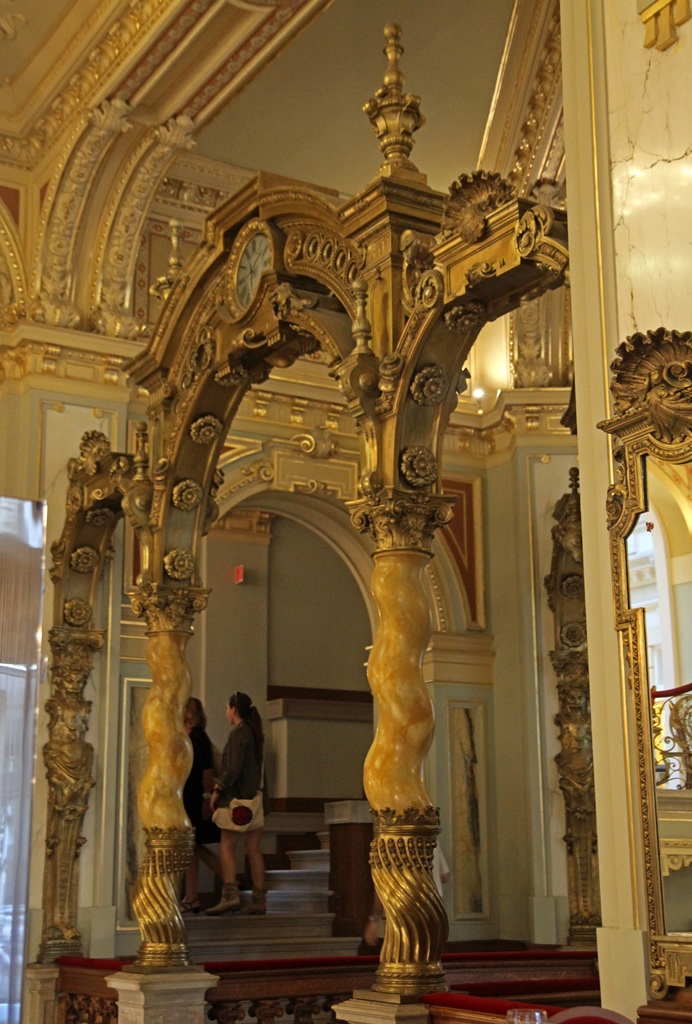
Entryway, New York Café
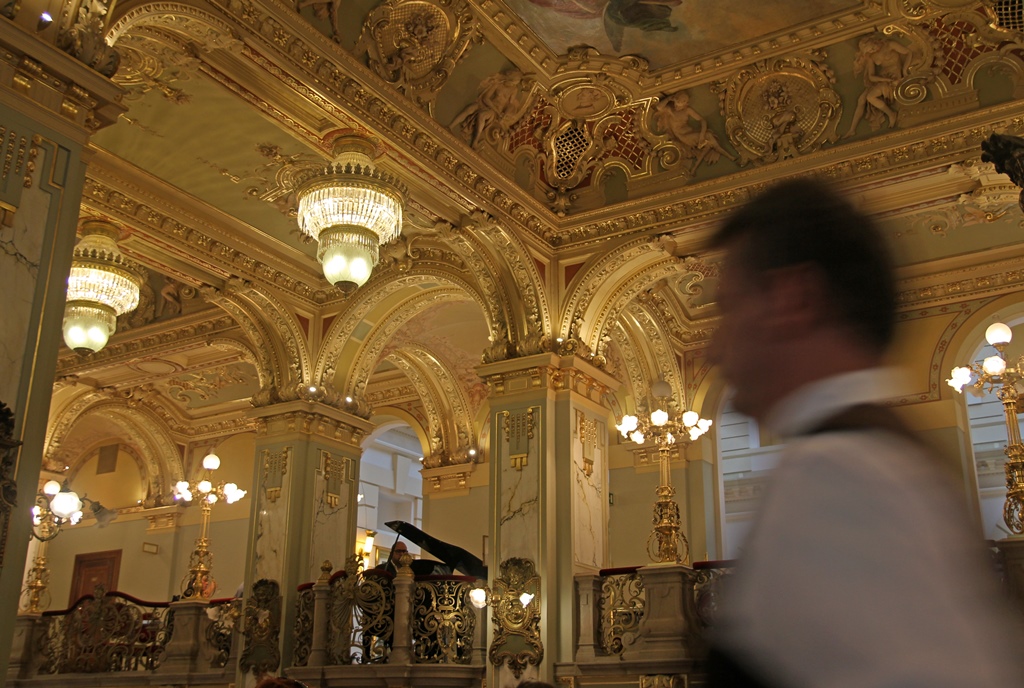
Waiter and Décor
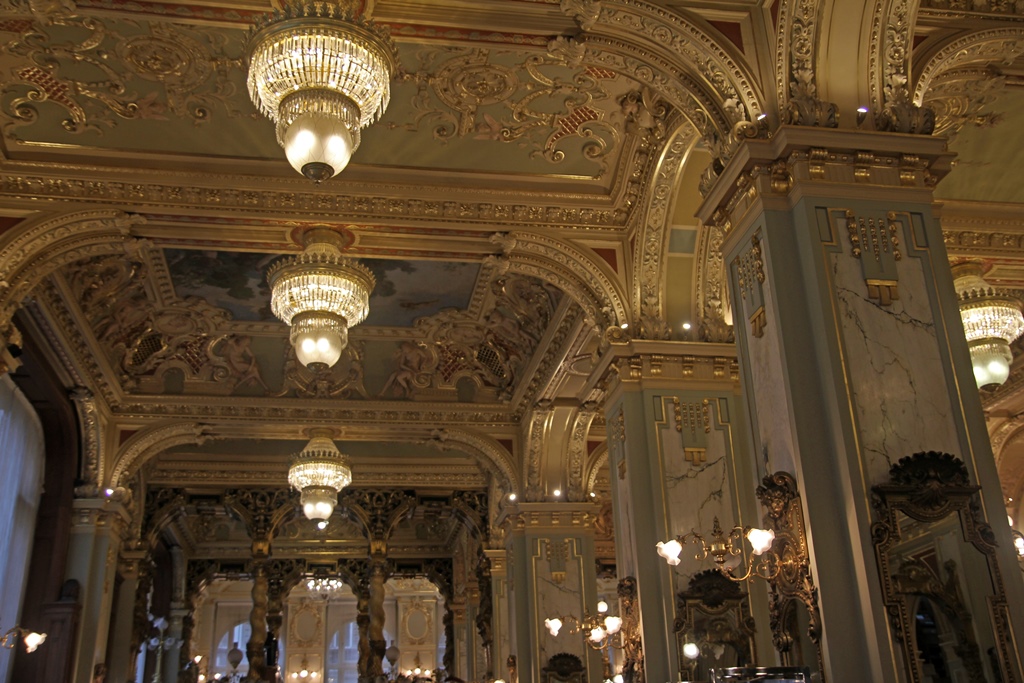
Columns, Ceiling and Chandeliers
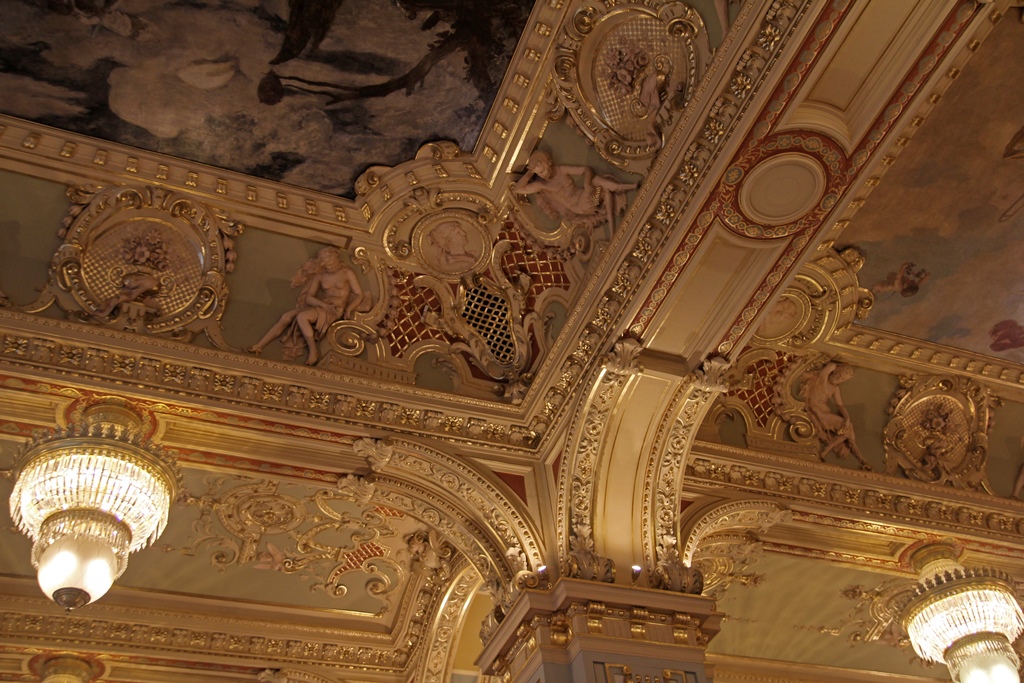
Ceiling Detail
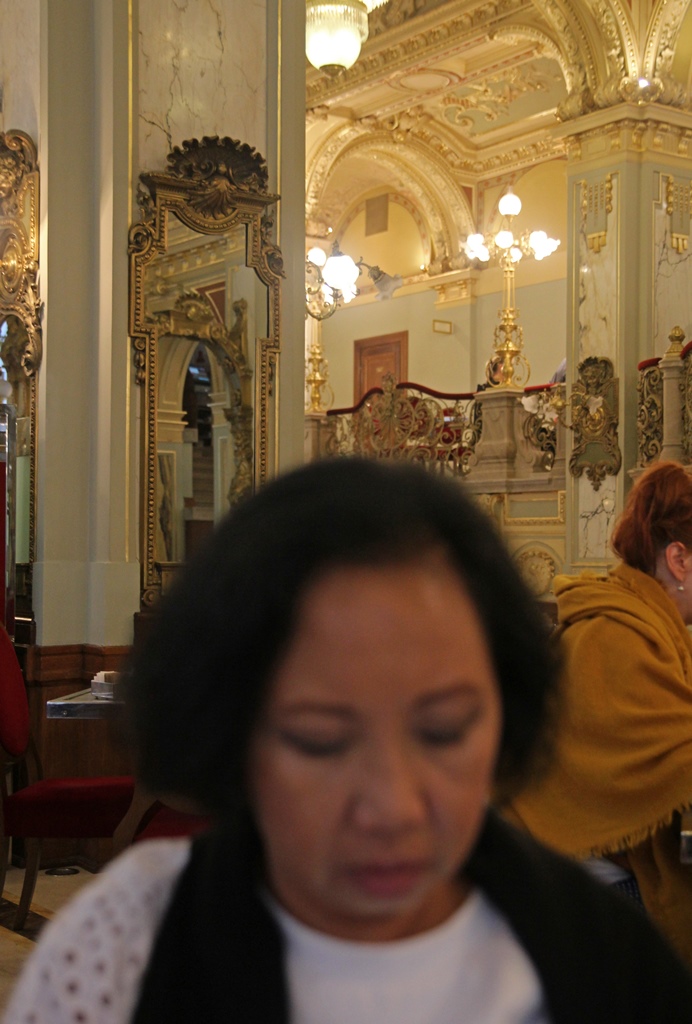
Nella Examining Menu
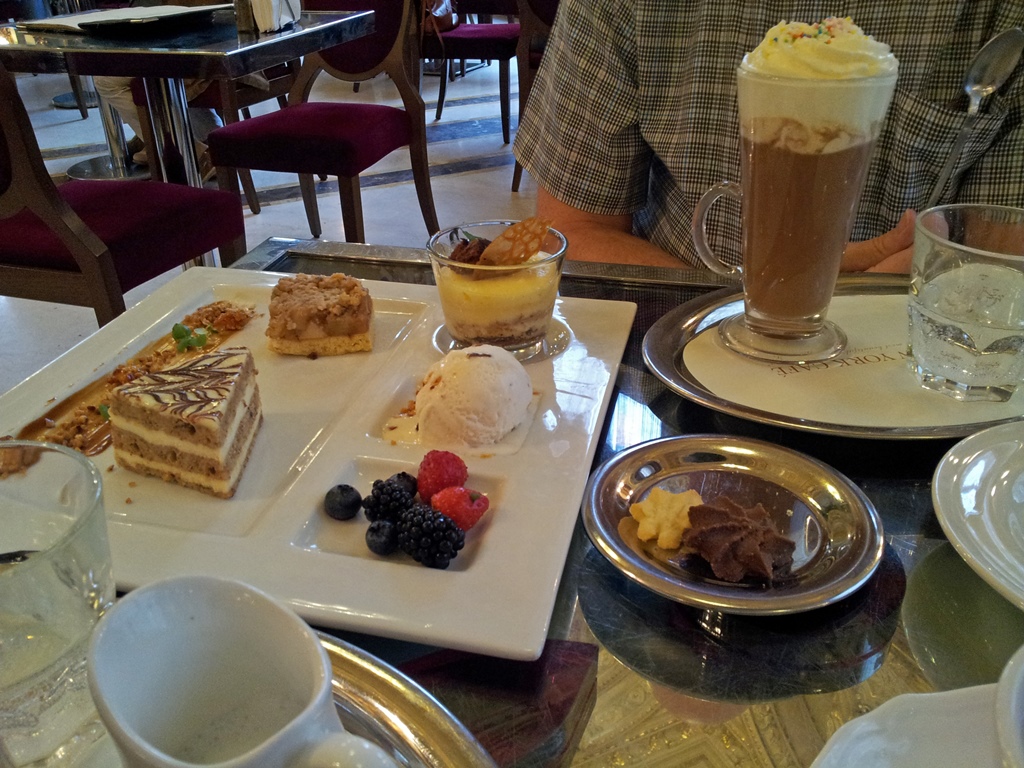
Desserts, New York Café
From the Café we took the Metro back to our hotel, rested up some and began
preparing for our departure the next day. Our next destination was the other center
of Austria-Hungary – Habsburg Central and the waltz capital of the world. Vienna.

